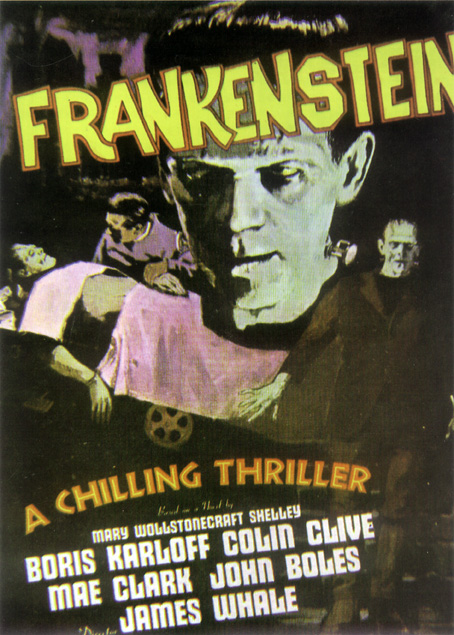 PREVIOUS PAGE:
A promotion poster of "Frankenstein", released in 1932 by the Universal Pictures Corporation.
A film adapted from the book by Mary W. Shelley: Frankenstein, directed by James Whale, and with Boris Karloff, Colin Clive, Mae Clark and John Boles.
PREVIOUS PAGE:
A promotion poster of "Frankenstein", released in 1932 by the Universal Pictures Corporation.
A film adapted from the book by Mary W. Shelley: Frankenstein, directed by James Whale, and with Boris Karloff, Colin Clive, Mae Clark and John Boles.
• [XI -- II (26) 27 Março [March] 1976, pp. 2 and 7].
There is little else to say about 'the Silent Years' in Macao, but before we unfold our narrative into the advent of synchronised sound with image we feel it necessary to recapitulate the events of the last years of the 1920s and the first two of the 1930s, in this land.
In 1927, Macao was possessed by widespread optimism. The impact of a prosperous world was reaching the colony. The flop of the Outer Port development project was not yet fully obvious as the reports of those in charge of the feasibility studies kept promising in grandiloquent manifestations a future flow of merchant ships of considerable tonnage. The fishing industry was certainly booming. By then more than a thousand vessels were registered in the Capitania dos Portos (Ports Authorities). There was large speculation about the modernization of Macao, ideas of promoting the isolated 'Mediterranean town' anchored to mainland China to an active metropolis of 'American' profiles.
That optimism generated the production of the first and only Feira Industrial (Industrial Fair), inaugurated in the empty fields of Mong Há, near the present-day [1976] social housing adjacent to Avenida Coronel Mesquita, bordering a small lake which no longer exists. The industrialists of Macao took this opportunity to exhibit their potentialities and, according to the 'sons and daughters of the soil', the fair was a matter of pride to the city and its organizers.
Our memory only retains the thrills of the amusements' section. There was a caroussel, a helter-skelter, a big-dipper, a merry-go-round, lots of booths and plenty of other attractions where small trinkets could be won as well as heaps of sweets. The romantics and lovers could go rowing on the lake.
The fair certainly set the pace for those times in Macao and stimulated the colony with the certainty of a complete renewal. The fair and the deepwater Outer Harbour were the landmarks of a new era. To this impetus was the gratifying promise that Macao was going to join the circuit of world tourism resorts, thanks to the construction of two new and modern hotels: the Hotel Riviera, inaugurated on the 13th of February 1928, and the President Hotel, the first 'skyscraper' of the city, to be inaugurated in the summer of 1927.
The massive structure of this hotel, erected on an empty piece of land facing the Cinema Vitoria, was considered as an impressive construction by the residents of a town in which buildings were no higher than two stories. This 'monument' aroused the general rapture of the public, and was expressed in an article which appeared in the newspaper "A Pátria" on 21st April 1928.
PRESIDENT HOTEL
"Soon the most impressive building of this colony will be inaugurated. It is the first skyscraper of Macao, being in width ninety-six feet,in length ninety-six feet, and in height one hundred and ninety-six feet. The first, second and third floors of this majestic hotel have an overall number of seventy-eight rooms, each floor having twenty-six rooms, to be luxuriously furnished. The hotel will have a maximum capacity for one hundred and fifty people. There will be a restaurant in the fourth floor, and a tea-room and roof-garden on the fifth floor. On sixth floor there will be a cinematographer with a capacity for four hundred and forty people, and the seventh floor will be used for open-air concerts. The total cost of the construction is about $500.000. Its window and door frames and all other mouldings are made of the best available teak. The electricity network is one of the major features of this building, the kitchens being provided with the most modern and economic electric appliances. Ventilation, heating and refrigetation, etc., etc..., all is electrically powered by equipment entirely purchased from MELCO. The hotel elevators are practically operational, their instalation contract also having been contracted to MELCO. These lifts have a rising thrust of two hundred feet per minute, i. e.: sixty feet per minute. One of the lifts will be exclusively used to take food to the fifth floor."
This hotel would later be renamed the Hotel Central (Central Hotel), "the tallest of the Portuguese Colonial Empire", as the concessionary company's advertisements boasted. The President cinematographer would not last long. It showed silent movies and then, mostly Chinese, which in those days were not of superior quality. The space of the cinematographer was transformed into a 'cabaret' which would reign supreme in Macao during the years of the Pacific War.
At the same time another building was under construction, again considered imposing by Macao's contemporary standards. This was the Correios, Telégrafos e Telefones ([CTT] Post Office, Wireless and Telephones) in Largo do Senado (Senate Square). It was generally considered to be a modern majestic construction. At the time no one seemed to notice its heavy and architecturally unstylish elevations which would obviously jarr with the facade of the Leal Senado and the other buildings of the Square with their arcades and balconies, of a charm only later to become appreciated.
Enterprise and prosperity joined hands in those days to promote developments which projected the effusive spirit of the times. Amongst the major Macanese ventures of those days was the submarine cable linking the mainland with Taipa, inaugurated on the 11th of November of that same year [1928]. Some days later, on the 19th of the same month, CTT solemnly opened with the presence of the Governor their Cable & Wireless services, operating from the second floor of their new building.
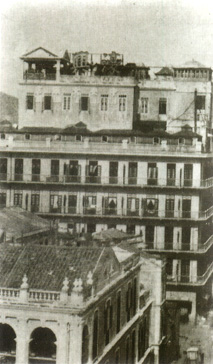 The Grande Hotel Central.
Built in the Avenida Almeida Ribeiro, around 1931.
The Grande Hotel Central.
Built in the Avenida Almeida Ribeiro, around 1931.
The 8th of December of that same year saw the opening of the Automatic Telephone Central services. The advanced technology of the Macanese telephone network became a matter of pride and wonder for a great number of local people. The daily "Jornal de Macau" even published a directory of the numbers immediately available through the automatic network. We will cite just a few:
623: Ribeiro Júnior, Delfino — Rua do Campo, no. 3.
637: Rodrigues, Fernando (escr.) [off.] —Travessa do P. e Narciso.
720: Rodrigues, Alina de Sousa Fernandes — Calçada do Bom Parto, no. 2
731: Rodrigues, Damião (res.) — Avenida Conselheiro Ferreira de Almeida, no. 93.
738: Silva, Dr. Henrique Nolasco (escr.) [off.] — Avenida Almeida Ribeiro.
801: Macao Electric Company (Secção de Informações) [Enquiries Department] — Rua Central.
815: Hotel Riviera — Rua da Praia Grande.
816: Tai San Li—Travessa do Soriano.
835: Paradis des Dames — Rua da Praia Grande.
943: Menezes, Celeste — Avenida Conselheiro Ferreira de Almeida, 95-B.
Sports were also undergoing a period of frantic activity. At campal an incipient new generation of hockey players, who would later be the pride and honour of Macao, was taking shape. Football teams such as the "Argonauta", the "Tenebroso" and the team of the Sociedade União Recreativa (Union Amusement Society) were scoring high. But the most popular of all sports was tennis, promoted through a series of competing championships such as those of the Ténis Civil (Civil Tennis [Club]), Ténis Militar (Military Tennis [Club]) and the Grande Torneio de Ténis Xangai-Macau (Great Shanghai-Macao Tennis Tournament).
·[XII — II (27) 14 Abril [April] 1976, pp. 4 and 5].
This Tennis Tournament supposedly confronting teams from Shanghai and Macao which took place late November 1929 ended up being an amiable and cosmopolitain event with players from both cities commonly playing matches in partnership. The Shanghai players were: Mlle Telma Colaço, Raúl Canavarro (the Shanghai championship), Gordon Lum and Paul Kong -- these last two having represented China at the Davis Cup. The tennis players who participated in the matches of the Ténis Civil club were: Mlle. Emília Figueiredo, João de Vila Franca (the Portuguese champion), José Maria de Senna Fernandes, António Melo, Raúl Xavier and Alberto Jorge. The matches were greatly applauded not only by the agility of the players but also by their sportsmanship and elegance. The most exciting match which riveted the audience was a Portugal-China contest having as respective contenders Raúl Canavarro and João de Vila Franca, and Gordon Lum and Paul Kong. China won after fierce balling.
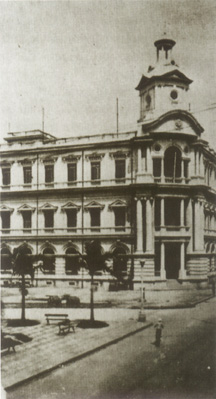 The new Correios, Telégrafos e Telefones ([CTT] Post Office, Wireless and Telephones) Macao headquarters.
Built in 1931, on the corner of the Leal Senado Square with the Avenida Almeida Ribeiro.
The new Correios, Telégrafos e Telefones ([CTT] Post Office, Wireless and Telephones) Macao headquarters.
Built in 1931, on the corner of the Leal Senado Square with the Avenida Almeida Ribeiro.
Visitors were welcomed with the very best of Macanese hospitality. The event started with a reception at the Clube de Ténis da Areia Preta (Black Sand Tennis Club) where some friendly matches took place. The following day was marked by an outing to Tong Ká, a fishing village in China, about fifty kilometers northeast of Macao. The 'top' matches took place at the Ténis Civil and lasted two days. The programme ended with an elegant dinner party at the Hotel Riviera. Participant visitors stayed for some more days by courtesy of other local tennis clubs, such as the Ténis Militar, Ténis Naval (Navy Tennis [Club]), and others. The final event was an avenging match between China and Portugal, played by the same teams. The China team won once again but had to fight hard to get the decisive scoring.
Those times' elevated the cult of sport was also expressed by a number of other activities. Those were the golden days of bicycle racing! We remember well the cycling rage that started in the middle of the 1920s in response to an encouragement to promote that activity broadcast by the Núcleo Desportivo "Pátria" ("Pátria" Sporting Nucleus), whose major adept was staff of the Serviço de Marinha (Naval Forces).
The 'body and soul' of Macanese cycling was Júlio A. Bento, popularly known as the 'Pau Preto' (lit.: Black Wood), the unchallengeable winner of that era.
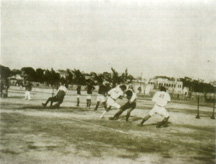 Playing 'Tug-of-war' at the campal (sporting fields).
The site is presently the Canidrome, near Mong Ha. On the background can be seen the still existing police station.
Photograph taken around 1930.
Dr. João Loureiro Collection.
Playing 'Tug-of-war' at the campal (sporting fields).
The site is presently the Canidrome, near Mong Ha. On the background can be seen the still existing police station.
Photograph taken around 1930.
Dr. João Loureiro Collection.
The greatest event of all cycling activities ever to take place in Macao was the One-Hundred Kilometers Race Macao-Tong Ká-Macao. The first of these marathons celebrated the National Day of the Portuguese Republic, held on the 5th of October. The twelve enrolled cyclists departed from the Government Palace, in Praia Grande. From "Jornal de Macau" we were able to collect the names of some of the runners: Júlio Bento, Pietro Colombo (Italian), Carlos Borges Delgado (son of the present-day Director of the Liceu), Manuel Rodrigues (from Guarnição Militar (Military Corps)), Manuel Dias Correia (also from the Guarnição Militar), Samal Khan (a Moorish policeman) and Francisco Pinto.
Júlio Bento, the 'champion', was in a spate of bad luck right from the start. He first fell on the bend of Jardim de S. Francisco (St. Francis Garden). After healing his bruises and fixing his bike he rejoined the race with considerable delay, recovering the lost time with astonishing stamina, reaching Tong Ká only a few minutes after the head runner. On his way back he fell once again, this time in A-Chac. Once again he rejoined the race, later managing to overtake the head cyclist and was a minute ahead of the others when, just after Ku-Oc, he fell for the third time. By now, his bicycle was so badly damaged that he had no alternative but to quit.
The second One-Hundred Kilometers Race took place on the day of the Armistice, on the 11th of November. There were fourteen participants and Júlio Bento was the crowds' favourite competitor. But luck was not on his side. Going confidently and in good shape, and well ahead of all the others, once again he had an accident at Ku-Oc, exactly on the same spot which had victimized him in the previous race, and as before he was forced to abandon the race. Manuel Rodrigues was the winner closely followed by Manuel Dias Correia. The troops of Guarnição Militar were delirious with joy and they were enthusiastically cheered upon arrival at the Government Palace, in Praia Grande.
Unfortunately these memorable races were never again to take place. They contributed much to strengthen good relations between Macao and China, the mainland authorities greatly contributing towards their success by greatly cooperating with whatever was needed along the stretch in the Province of Guangdong.
The first horse races took place in the openfield of the future Hipódromo (Hippodrome). The Macao Jockey Club had not yet been created and the racing track was more like a running path. Although its borders and fences were improvised there was a genuine spirit of exhiliration in the air. The British were the greatest enthusiasts and spent fortunes bringing horses from Hong-Kong for the sheer joy of seeing them running competitively. It was a frenzy similar to that excitement which these days precludes the Macau Grand Prix car races.
Hockey became another top sport of the colony with weekly matches every Sunday. The Macao team was repeatedly the winner. Trained by the 'great' Lieutenant Filipe O'Costa, the 'boys' presence irradiated an impressive charisma of discipline and camaraderie remote from the actual professional practise of sport.
 Playing football at the campal (sporting fields).
Photograph take around 1930.
Dr. João Loureiro Collection.
Playing football at the campal (sporting fields).
Photograph take around 1930.
Dr. João Loureiro Collection.
1929 was a fecund year for Macao in enthusiasm and confidence in its prosperous future. The Annual Report of the Commissary of the Chinese Customs, at Lapa, out in July, reads favourably and positively. The Report deals at length with the progress of multiple Macanese industries, and enhances the importance of the promotion of the Horse Races as a tourism source of income for the Colony. Then, there is jubilation about the eight kilometers of road built that year between Macao and Seac K, built by the Repartição das Obras Públicas (Public Works Department) of Macao in Chinese mainland with the assistance of the Authorities of the Province of Guandong. This stretch of road, starting at Portas do Cerco (Border Gate) was officially inaugurated by the Governor Tamaginini on the 18th of March.
The asphalted road decisively contributed towards the economy of Macao and the upgrading of its commercial relations with the neighbouring 'hinterland'. The Kee Kuan Bus Company started operating lines from a number of points in the province of Guangdong to Macao, with many automobiles daily crossing the Portas do Cerco. Particularly during weekends there was a heavy flow of driving commuters who invaded the mainland picnicking; hunting turtle doves, partridges and snipes, fishing in all the crooks and crannies of the meandering nearby rivers, riverlets and water sources.
What good memories we have of those outings! How many sites we visited, places which would gradually became familiar: Chin Sán, Chôi Mei, Ku Oc, Tong Ká, Li Tchai, Seac, Vong Mau Tché— the Águas Quentes (Hot Waters) [sic] —, and Choi Hang — Sun Iat Sen's birthplace. In our memories rest the delights of snacks savoured by the edge of roadways closely shadowed by pagoda trees, lingering sights of bamboo plantations bending with the whistling of the wind, and the water buffaloes with their noses up in the air, partially immersed in the muddy bogs of the paddy fields, and the country folk, smiling at us, crossing over the archaic stone bridges, … and there was also the pungent smell of the rice husks ripening in the sun which would assail us wherever we went What a good life it was!
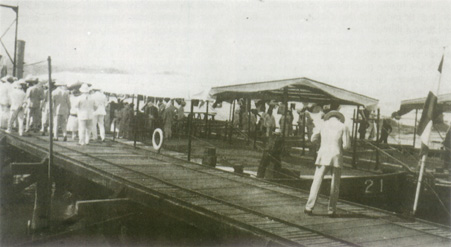 The mooring at the Outer Port, near the S. Francisco Garden.
Photograph taken around 1930.
Dr. João Loureiro Collection.
The mooring at the Outer Port, near the S. Francisco Garden.
Photograph taken around 1930.
Dr. João Loureiro Collection.
That year also saw the dawn of an incipient contribution to Macanese tourism. On the 21st of September the Balneário-Restaurante Costa do Sol (Costa de Jade Bathing Resort-Restaurant Jade Coast) was inaugurated on the Bay of Pac On, at Taipa. This bay has been destroyed by the landfill of the bridge Ferreira do Amaral, which connects Taipa with the city of Macao, the Costa do Jade being at the place where there is now the small roundabout connecting the bridge to the marginal road of the island. It was a grand event. Hundreds of people were ferried over on the ferry "Jade" built specifically for that purpose in the Oficinas Navais (Naval Chandlery). The guests boarded the ferry in a stone mooring which bordered the Bay of the Praia Grande at the S. Francisco bend.
The Balneário was delightful. At that place the seawater was extremely clear (not being yet contaminated by muddy silt), the luxuriant little forest of the Sete Tanques (Seven Tanks) stood just above the site with its precipitous riverlets emmiting a gentle murmur of running freshwater.
It would later become a saying amongst the Macanese nostalgic of the pleasures of that splendid Autumn of 1929 that:
— "Foi moda ir à Costa de Jade." (— "It was fashionable to go to Costa de Jade."). There was an incessant succession of parties and 'American' dinners animated by the jazz band of João Franco. And many were the prospective marriages which were unexpectedly initiated to the inspired and melodious tunes of "I'll See You In My Dreams" and the tenor accords of "Ora Sorriento", in nights of full moon with silvery sparkles shining offshore while the shipping junks silently gleamed past, heralding full-sail!
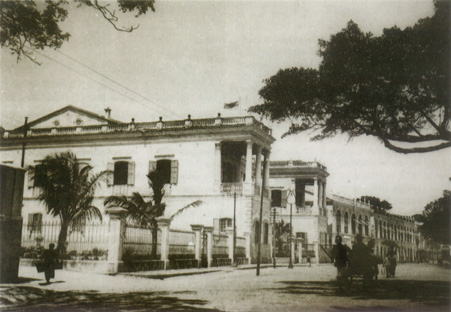 The Government Palace (foreground), the old Post Office and the Hotel Macau (background), in the Avenida da Praia Grande.
Photograph taken around 1930.
The Government Palace (foreground), the old Post Office and the Hotel Macau (background), in the Avenida da Praia Grande.
Photograph taken around 1930.
What fun! The overwhelming optimism, the joy-of-living and the inexpensive and easy-going atmosphere of those times in Macao seemed not be affected by the tragic realities of the contemporary world. Civil War in China between the Central Government and the warlords were minor troubles for the colony. We had all been brought up with the historical knowledge of China's continuous internal turmoil, from the bloodthirsty consequences of hatreds and ambitions which forever assailed and impoverished that great country.
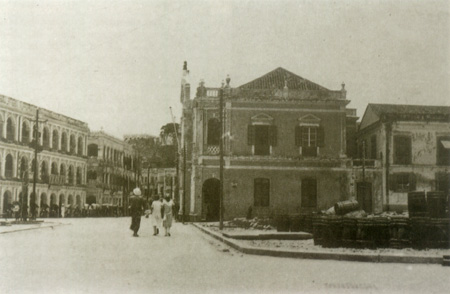 The Leal Senado Square looking towards the S. Domingos church.
On the right is the Misericórdia (Misericordy) (side elevation facing). On the background is the Fortaleza do Monte (Mount Fort),
Dr. João Loureiro Collection.
The Leal Senado Square looking towards the S. Domingos church.
On the right is the Misericórdia (Misericordy) (side elevation facing). On the background is the Fortaleza do Monte (Mount Fort),
Dr. João Loureiro Collection.
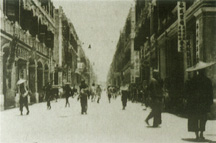 Avenida Almeida Ribeiro.
Looking down from the Leal Senado Square towards the Inner Port.
Photograph taken around 1930.
Dr. João Loureiro Collection.
Avenida Almeida Ribeiro.
Looking down from the Leal Senado Square towards the Inner Port.
Photograph taken around 1930.
Dr. João Loureiro Collection.
Astonishing as it may be, not a single Macanese daily gave the news of the crash of the New York Stock Exchange in that ominous October "Black Tuesday". Neither was news of the ensuing economic disaster which originated the critical years of Depression and multiple related suicides. Hong-Kong and Macao were remote corners of the world where prosperity seemed to have arrived to stay and where the slightest cause for alarm did not exist. During those times, and despite its magisterial contemporary movies, the industry of silent cinema was agonizing. More than rumours were spreading that the recent discovery of sound synchronized with image would soon make silent movies redundant. Already thinking about the future, the "King" and "Queen" theatres then under construction in Hong Kong, took precautions to eventually operate with the novel projection equipment.
•[XIII—II (28)4 Maio [May] 1976, p.2].
Those less knowledgeable of the history of the cinema might think that movies with sound were a prodigious technical achievement from the late 1920s. This is quite wrong. In fact, already before the turn of the century there had been attempts to synchronize sound with moving photographs. In 1894, Thomas Alva Edison developed with considerable more success the Kinetoscopo, a tubular sound conducting contraption connected to the viewer's ears. Along those lines Edison would later develop other curious sound mechanisms such as the Kinetophone and the Synchoscope; and the German Carl Laemmle, the Phonofilm.
In 1921, D. W. Griffith — the great producer of "The Birth of a Nation" and one of those who most contributed towards rising cinema to an art media — was the first to register in film two-hundred feet of synchronized sound-and-image. Although far from perfect, this film entitled "Dream Street" was widely acclaimed by the public when it was first shown in the New York Town Hall. Despite the success of the showing the attempt was not further technically developed for commercial purposes.
But the idea remained. The film producing company Warner Brothers, controlled by the four brothers Sam, Harry, Jack and Albert Warner in assocation with Bell Laboratories, and jointly owned by the Western Electric and the American Telephone & Telegraph, was the first enterprise to make serious attempts to promote and distribute worldwide commercial sound movies. First the "Vitaphone" sound system was overlayered to John Barrymore's silent movie "D. Juan". The track was just classical music played by the New York Philharmonic Orchestra conducted by Henry Hadley and sung by the famous Giovanni Martelli and Marian Telley of the Metropolitain Opera House, accompanied by a choir. The film became an immediate success but can still be considered as an experiment in a novel mixed-media.
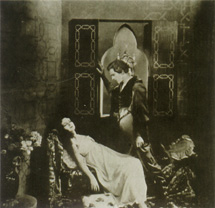 "Don Juan", released in 1927 by the Warner Brothers Pictures Incorporated. A scene of the film with John Barrymore.
A film adapted from Lord Byron's poem Don Juan: A Satiric Epic of Modern Times. One of the first films equipped with sound effects, partially accompanied with extracts from Mozart's opera of the same name.
"Don Juan", released in 1927 by the Warner Brothers Pictures Incorporated. A scene of the film with John Barrymore.
A film adapted from Lord Byron's poem Don Juan: A Satiric Epic of Modern Times. One of the first films equipped with sound effects, partially accompanied with extracts from Mozart's opera of the same name.
In general, the cinema industry by then comfortably settled into distributing silent movies which were box-office successes, remains sceptic about the impact of sound movies. Some of the greatest starts of the silent era openly express their discontentement about this revolutionary cinematographic procedure.
But Warner Brothers persisted in developing its ideas and, in October of 1927, Al Jolson not only sang but delivered a brief monologue of about two-hundred words in the "Jazz Singer", a film where Eugene Bassarer interprets the artist's mother. This is an historical turning-point in the history of the cinema.
The film addresses itself to the big public, and not to an elitist and art-orientated audience. The crowds vibrate with excitement and were riveted with the sound-and-image performance. The voice of the singer reached the spectators' eardrums loud-and-clear, and with his every single word being clearly understood, the unaccustumed public had the sensation that the artist was there, alive, on stage. Continuously sold-out shows made a huge profit to Warner Brothers. From one moment to the next Al Jolson catapulted to world fame. In view of the success, Warner Brothers made a sequel of its first sound-and-image commercial venture, releasing in 1928, also with Al Jolson, a partially sonorised visual story called "Singing Fool". The cinema halls were full of crying spectators moved by Jolson when holding in his arms his dying son, performed by David Lee, sang the unforgetable "Sonny Boy".
The other cinema production companies were hit by surprise. Fox, under the dynamic management of William Fox immediately decided to follow suit. Many silent movies under cuZrrent production were immediately stopped and shelved. The sound system "Movietone" was hastily developed and tested in the "Four Devils", with Janet Gaynor, Charles Morton, Naney Diexel and Barry Norton. There were huge queues of people aligned to purchase tickets at the movie theatres' box-offices; the shows were permanently sold-out and the success was colossal.
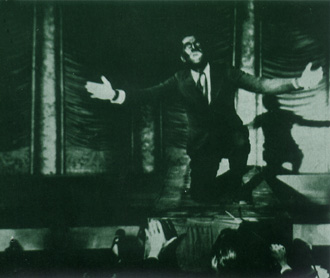 "The Jazz Singer", released in l927 by the Warner Brothers Pictures Incorporated. A scene of the film, with Al Jolson.
A film based on the play by Samson Raphaelson: The Jazz Singer, based on the short play by the same author: The Day of Atonement.
"The Jazz Singer", released in l927 by the Warner Brothers Pictures Incorporated. A scene of the film, with Al Jolson.
A film based on the play by Samson Raphaelson: The Jazz Singer, based on the short play by the same author: The Day of Atonement.
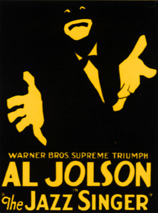 A promotion poster of "The Jazz Singer".
A promotion poster of "The Jazz Singer".
On the 15th of July 1928, the energetic Warner Brothers released their first movie fully accompanied by 'integrated sound', "The Lights of New York" starring Curtiss Landis and Helen Costello. Immediately after they released "Disraeli" with George Arliss. Metro-Goldwin-Mayer decided to join the band-wagon and produced "The Trial of Mary Dugan" with Raymond Hackett and Norma Shearer, and "Madame X", starring Ruth Chatterton and Raymond Hackett. Universal was quick to also produce its first sound release with "Show Boat", starring Joseph Schilkraut and Laura Laplante. Although only partially with sound, this film was to become extremely famous through the excellent performance of its cast and by the American folk songs and music of Jerome Kern, giving immediate fame to the composer.
1929 was really the first year of the 'talkies', i. e. the global commercialization and acceptance of synchronised sound-and-image movies. It is also celebrated as the last year of a silent masterpiece: MGM's "The Kiss", with the outstanding acting of Greta Garbo. Although the 1930s continued to see a steady production of silent movies these were all second-rate. Two extraordinary silent productions of that decade are worth mentioning: "City Lights" (1931) and "Modem Times" (1938). Produced and performed by Charles Chaplin and consciously conceived without sound well into the "talkies" times, the structure of their script, the sequel of the scenes and their imagery, and the powers of artistic communication of Charles Chaplin invalidated their adaptation the format of the new film techniques.
There was widespread panic amongst the 'old school' actors and producers. The 'talkies' required a more realistic way of acting and the careful modulation of the protagonists' voices instead of the exaggerated facial and gestural mimicry common to the silent movies. All actors trained in these novel performance requirements as well as in voice control. In the upsurge of this stage fright appeared multiple charlatans selling 'miraculous' beverages to enhance the calibre of one's voice, … and multiple young and old talented movie stars spent fortunes in sheer disorientation. These transitional times from the 'silent' era to the 'talkies' boom saw the most, the unravelling of the most varied human stories, some tragic and dramatic, others exciting and surprisingly stimulating.
•[XIV — II (29) 20 Maio 1976, pp. 4-5].
Actors such as Gary Cooper, Clark Gable and John Wayne who had only been give secondary roles during the silent times were suddenly propelled to stardom. Others, such as the acclaimed prestigious Norma Talmadge and Gloria Swanson, recognizing their shortcomings to adapt to the demands of the changing times, abandoned cinema in full glory after a brief trial in the new medium. Others still, such as Clara Bow, Renée Adorée and Laura Laplante, despite overcoming with success the impact of the synchronization of sound with image, came to realize that their best times were over and abandoned their cinematographic careers. But a great number decided not to even try and disappear from the screens without trace. Few are the famous actors from the 'old school' whose prestige remains unscathed. The "Divine" Greta Garbo makes the transition in full glory and reconfirmed her charisma, delivering her first lines in "Anna Christina" (1931), her first sound movie. Finally, some actors bravely fought to maintain their previous popularity, despite successively losing ground before being forced to quit. Such is the sad end of John Gilbert.
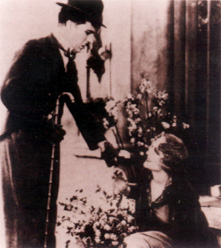 "City Lights", released in 1931 by. A scene of the film, with Charlie Chaplin and Jean Harlow.
A film directed by Charles Chaplin.
"City Lights", released in 1931 by. A scene of the film, with Charlie Chaplin and Jean Harlow.
A film directed by Charles Chaplin.
After Rudolfo Valentino, John Gilbert became one of the greatest idols of the silent times' public. Already in 1928, the superstar of "The Flesh and the Devil" and "The Big Parade" had a top income of more than a million dollars a year, a sum that for those days was considered astronomic. He was the prototype of the great silent lover and his continuously speculated affair with Greta Garbo was top story in all the major tabloid magazines. Gilbert was the ardent and daring macho. His small moustache was one of his 'trade marks'; his profile a source of wild feminine enrapturement. A major star of 'the Silent Years' he was in all girls' hearts who, at least, had a photograph of their 'beloved'.
He left no statements about his feelings towards the introduction of sound to the movies, but he must have been so confident of his apparentely unshakable stardom that he programmed five talkies with MGM, his producing company. No one seemed to notice that, although the actor had all the physical prerequisites to enthrall the feminine crowds, he was lacking a major asset to triumph in sound movies: a 'good' voice. Gilbert's voice was high pitched and feeble, and totally incompatible with his seductive looks and virile impetuosity.
The opening of his first talky "His Glorious Night" was preceded by a wave of emotive sensationalism. It was going to be possible to hear Gilbert 'live' on the screen. Anxious fans delirious to be the very first to hear the voice of their 'beloved' frantically queued for the opening of the box offices. But their great expectations turned to disappointing anti-climaxes. The star's faint's tenor, weak voice, quasi-effiminate, clashed with the star's projected character of pulsimanious vigour. His fans did not take kindly to this tremendous delusion and responded swiftly, pulling jokes at his performace instead of sighing and heart throbbing.
Gilbert's career was finished from one moment to the next. In his second talkie he no longer lead the cast but appeared second, after Wallace Beery, until then not a public favourite. Gilbert became even more discredited in this movie. At a loss, MGM's board of directors decided to offer him one million for the rescission of the contract but Gilbert, arrogantely refused and insisted that his contract was to be fulfilled to the letter for the stipulated period of four years. MGM had to comply with the agreement but demoted the idol, cruelly giving him minor roles in second-rate mass-produced films which involved no major risks. The fallen idol could not face his fate, first he shouted and screamed abuse; then he implored and begged. He went to doctors and quacks. All in vain. His voice would remain the same.
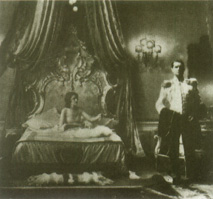 "Love Parade", released in 1930 by the Paramount Famous Lasky Corporation. A scene of the film, with Maurice Chevalier and Jeannette MacDonald.
A film directed by Ernest Lubitsch with sets by Hans Dreies and music by Victor Schertzinger. One of the greatest box-office successes of the early 'talkies'.
"Love Parade", released in 1930 by the Paramount Famous Lasky Corporation. A scene of the film, with Maurice Chevalier and Jeannette MacDonald.
A film directed by Ernest Lubitsch with sets by Hans Dreies and music by Victor Schertzinger. One of the greatest box-office successes of the early 'talkies'.
He became ostracised by the glamourous cinema society. Those who once before bowed to all his requests to have him in one of their movies, now even denied him access to movie studios. Inconsolable, Gilbert started drinking, and became a pathetic, lonely figure pacing up and down the waiting corridors of the major producers. The top movie houses frantically competing to top the box offices successes repeatedly denied him any important role. Only Garbo was faithful to their old friendship. When she offered the leading role of Queen Christina of Sweden in "Queen Christine" she accepted with the condition that Gilbert should play a prominent character in the story. But his voice once again betrayed his acting and the film became a major flop. From now onwards not even Garbo could assist him in his cinematographic career. Gilbert became a pale figure from his glorious days, his health deteriorated, dejected and demoralized he fought for a lost cause. In 1934 he accepted a subdued role in a minor film, "The Captain Hates the Sea". In this film he no longer played the amorous and romantic dominant male but the character of an alcoholic newspaperman — which suited him fine, as by then he had become an unredeemed alcoholic. Gilbert's acting was superb. Unfortunately, the actor died shortly after finishing this movie and the outcome of this success had no continuity. The 'legend' says that he died of distress.
But lets go back in time. 1929 was a turning point to the history of cinema. Silent movies had been banished forever. The crowds now raced to the cinema theatres for the sheer joy of 'listening' to the performing casts. The allurement of the actors' voices seemed to overshadow their performing skills and the film scripts. Before the opening of the 1930s decade more than five-thousand movie theatres with new sound-technology were operating in the States. Some of the very first talkies made such an impact on the audiences that they became cinema landmarks not because of their imagetic contents but because of the spell of their actors' deliveries.
Just to cite a few: "Sunny Side Up" with Janet Gaynor and Charles Farrel; "Rio Rita" with John Boles and Bebe Daniels; "Desert Song" with John Boles and Carlotta King; "Love Parde" with Maurice Chevalier and Jeanette MacDonald; "The Cockeyed World" with Edmund Lowe, Victor Maclegan and Lupe Velez; and "The Vagabond Lover" with Rudy Valee and Sue Ann Blane.
Sound technology allowed the mixing and transformation of sound tracks and enabled the creation of musical and complex variety movies. The advent of sound-movies saw these kinds of productions becoming increasingly popular, this public success creating a demand for increasingly elaborated and luxurious productions.
 "The Singing Fool", released in 1928. A scene of the film, with Al Jolson and Josephina Dums.
A film adapted from the play by Leslie S. Barrows: The Singing Fool, and directed by Lloyd Bacon.
It was the first 'talkie' shown in Hong Kong, in 1930.
"The Singing Fool", released in 1928. A scene of the film, with Al Jolson and Josephina Dums.
A film adapted from the play by Leslie S. Barrows: The Singing Fool, and directed by Lloyd Bacon.
It was the first 'talkie' shown in Hong Kong, in 1930.
The audiences raved about the fabulous dream-like sets where the top actors sang and moved surrounded by a myriad chorus girls and supporting tap-dancers choreographed with mathematical precision to the trepidating jazz rhythms of those days.
Music-crazy was a creation of the late 1920s. The top songs of those sing-and-dance movies became instant hits sung across the globe. Unforgettable are tunes such as Janet Gaynor's "If I have a talking picture of you" in "Sunny Side-Up", Dixie Lee's "Big City Blues" in "Fox Follies of 1929" and Rudy Valee langurous" If you're the only girl' in "The Vagabond Lover". What a great sensation it was listening to the Brox Sisters, Buster Keaton, Marin Davies, Joan Crawford and George K. Arthur rhapsodising in "Singing in the Rain" (by Nacio Herb Brown) in "The Hollywood Review of 1929"!
From the numerous musical movies of those times, those who created the greatest impact when released were: "Broadway Melody of 1929" the award-winning film of "Gold Diggers of 1929"; "Fox Follies of 1929"; "The Hollywood Review of 1929"; and "Show of Shows". In 1930 Paul Whiteman's "King of Jazz" was released with hundreds of actors and an extraordinary array of musical scenographies; and "Happy Days" with the breathtaking number "Crazy Feet" by Dixie Lee.
But did Macao react to this cinematographic 'revolution'?
By the early 1930s the excitement of the talkies was well known in the colony. Particularly the cinema magazines dedicated abundant reports on the progress of the new media. This news was eagerly read by the multiple cinema enthusiasts, curious of this great novelty. The Hong Kong daily papers and magazines incessantly praised the new technology under bombastic terms. It was therefore not surprising that the 'sons and daughters of the soil' followed with increasing trepidation the erection of the new theatres which would incorporate these most recent cinematographic technologies.
Although it was impossible to gather documental evidence of the first sound movie exhibited in Hong Kong, various oral sources unanimously confirmed that it was Al Jolson's "Singing Fool", shown at the brand new "Queen's". Many enthusiasts went from Macao for the grand event, either on the Sui Tai or in the Sui An, the two vessels which ferried between both colonies, the crossing taking longer than four hours.
As in the rest of the world, the success of "The Singing Fool" in Hong Kong was absolute! Some people stayed from one show to the next, emotionally shedding tears every time. At the "Queen's" people sobbed to their hearts' content, muffling Jolson's throaty voice choaked with distress, singing "Sonny Boy" to his dying son (Davie Lee). Feelings were no longer just communicated through gestures and facial mimicry; there were dialogues, arrested phrases, the sad tone of Jolson's voice which so much touched one's heart. For the audiences used to silence the shock of sound was 'arresting', the audience feeling transported from their seats in the auditorium into the screen, partaking the events which were taking place.
Younger generations who have always been used to seeing the image concomitantly with sound cannot sense the thrill of those magic moments in the darkness of the "Queen's" threatre or really understand the impact of the first talkies on the contemporary public.
·[XV — II (30) 12 Junho [June] 1976, p. 4].
The exit of sound pictures was absolute. In Macao it became everyday chat, in gatherings, at home, on the streets.
— "Have you been to the talkies in Hong Kong?" — was the most frequent question those days. At the weekends dozens of people commuted to Hong Kong with the express purpose of going to the cinema. After the "Queen's" success other theatres equipped with sound soon opened: the "Majestic", the Central and later the "King". The excitment was so frantic that it was almost vicious.
We know two couples who once left Macao at half-past eight in the morning, in the sleepy Cheang Chao, reaching Hong Kong at half-past twelve noon. They lunched at Jimmy's Kitchen -- those days unpretentiously plain -- and at half-past two were at the "Queen's". After the movie, they went to Kowloon to watch the five p. m. show at the "Majestic". From there, rushed back to Hong Kong Island on the Star Ferry to catch the main movie at the Central arriving late to catch all the introductory documentaries. Finally, skipping dinner, they ran to the "King's" just in time for the last session. Four different movies in just a day… and if the ladies didn't even think of going shopping it was because, in those days, going to the talkies was an obsessive attraction.
Such an experience was not abnormal for a number of 1930s Hong Kong and Macao movie enthusiasts. Sound movies were 'in'. Daily newspapers spared no efforts to praise to the very most this, the novel technical exploit of cinema. The "Jornal de Macau" dedicated two full columns the the premieres of "Sunny Side Up" and "Rio Rita" in Hong Kong. Seduced by the praiseworthy reports of the movies the readers could not resist commuting to Hong Kong.
The first talkie I saw was at the "Queen's". I was then a lad in the second form of Primary School. My father grabbed the opportunity of a couple of day's holiday to take all the family to Hong Kong, so that we would be able to experience with our own eyes and ears that "marvel" experience so highly praised.
The film was called "Marianne", with Marion Davis has the leading actress. It was a war comic. The plot revolved around the loves of an American soldier and a french peasant girl. The film was not up to much — in fact, it is not in any cinema anthology consulted — being one of the many trivial movies which were commercially churned but to less discerning audiences. But I will never forget it. I still remember the lines of its song "Oh Marianne" sung by the American GI. And I still remember my father's enthusiastic words on the way back to the hotel, after the show:
—"Fantastic! It was loud and clear!" And that night grew long as we exchanged remarks spellbound by what we had just seen and heard.
Back in Macao I no longer wanted to go to silent movies. Ungratefully, I felt conned by the accompanying music, impatient wiyh the intercut titles and dialogues. The Macanese movie theatres: the "Victoria", the "President" and the "Long Tin Mon Tói" — which had just reopened — were all loosing money.
The second sound movie which I also saw at the "Queen's", in Hong Kong, was "All Quiet on the Western Front", which opened with a gala night. It asserted itself by being the best war movie ever made following the anti-bellicose approach of "The Big Parade" and "What Price Glory". It was the classic of classicics… and, above all, had the enormous asset of sound.
The First World War had ended twelve years before and many were those who had fought in the battlefields and miraculously survived the insane carnage. It must have been a terrifying experience for all the war veterans to re-experience those moments with such reality. Associated with superb photographic shots there was the sound of exploding bombs, the mechanical shooting of the machine guns, the raucous yells of the soldiers, and the stampede bayonet charges. The spectator was not just a voyeur but was transfixed by the bombastic sound effects. And, adding to all the detonations was the dying screams of the moribund, and the agonizing pains of the wounded in the battlefields and in the improvised infirmaries. Together with image, sound transported the terrifying reality of war to the auditorium. It was frequent to see people who, overwhelmed by such sensations, had to leave the theatre. I vividly remember an Englishman who was sitting just behind me who, at a given moment, probably overcome by tragic memories of the trenches in Flanders or on the Somme, bent down and started vomiting. I carried for many years the scars of such visual emotions.
In Macao the ever dwindling number of spectators to the silent movies soon worried the empresarios. The President and the Long Tin Mon Tói were compelled to close and the Victoria, the last surviving movie theatre was faced with the dilemma of either updating its auditorum to sound technology or follow the fate of the two other cinemas.
Meanwhile, a group of entrepreneurs were already conceiving joining forces to subsidise the construction of a cinema auditorium capable showing sound movies. The idea took shape during the last half of 1930, Alfredo Maria da Luz being one of its major enthusiasts. The future Teatro Capitol (Capitol Theatre) had just been conceived!
On the 24th of January 1931 a short article entitled Empreendimento arrojado (Daring enterprise) in the "Jornal de Macau" signed by T. B. (Artur Tancredo Borges) disclosed the future existence of the Capitol and rejoiced about the advent of the talkies in Macao.
"In this land, where initiatives are so few and far between, and where in most cases lack the support of those should encourage them, we must rejoice with the daring enterprise of a group of capitalists, amongst others our friend Mr. Alfredo Maria da Luz, of building here a theatre specially programmed for the exhibition of sound movies.
The building, which has aready been started, will accommodate an ample auditorium with a balcony, stalls and boxes, having a capacity for around eigth hundred people.
The sound system will probably be supplied by the Western Electric Company, the first to market this type of equipment which has already been incorporated in more than seven thousand five-hundred theatres around the world, five thousand in the United States of America, one-thousand in Great Britain, three hundred in Canada, three hundred in Australia two hundred in Europe and one hundred in New Zealand.
In China there are — with sound equipment — eleven cinemas in Shanghai, two in Guangzhou, one in Amoy, one in Tianjin, and one in Beijing.
All three Hong Kong operating cinema theatres have been provided with Western equipment. The new "King's" theatre has also adjudicated its sound system to this company.
It is therefore with the greatest of joys that we announce that the public of Macao will equally be able to 'see and hear' the best actors that the major film production studios have contracted, enabling worldwide audiences to enjoy the impressive talents of their voices while performing in the most luxurious sets that human imagination has ever created.
Cinema is a fine way of learning but it is above all essential to choose the 'right' films, because Hollywood is creating a new notion of morality, a new notion which should not go beyond certain parameters...
Our warmest congratulations to the entrepreneurs who are bringing to this small corner of the globe this touch of progress, thus enabling the local residents those moments of pleasure which a good movie always conveys.
Wishing the greatest success to the Capitol Theatre we hope that its inauguration will take place as soon as possible."
•[XVI — II (35) 20 Agosto [August] 1976, p. 5].
Faced with the news, those running the Vitoria did not stand idle. This cinema's management now clearly understood that the theatre's survival depended from its modernisation. In haste, sound equipment was purchased and immediate adaptation works started in the old auditorium. There was now fierce competition between the brand new Capitol and the refurbished Vitoria, which in a way cheated its competition by buying second-hand sound equipment which was far from being top quality (but, anyway, much better than the equipment of the present-day Império*).
The Capitol was about to open when the Vitoria broadcasted its first movie sound sessions, although not yet open to the general public. The populace, anxious to have access to sound movies used to stop under the arcades of the Almeida Ribeiro Avenue alongside the Vitoria's side elevation to listen the sound 'transpiring' from the auditorium. Some went so far as to 'glue their ears' against the doors of the cinema. People commented:
—"The talkies have arrived in Macao!"
The "Jornal de Macau" of the 17th of March 1931, reluctantly printed the following news expressly admitting its sympathy for the management of the Capitol:
"In a few days the theatre Vitoria will start exhibiting sound movies. All necessary works are presently been carried out.
The interior refurbishment [of the theatre] to incorporate the new equipment affects a considerable area of the entrance hall, disfiguring it.
It is not known if the auditorium with the envisaged renovations destined to integrate the sound equipment will be acoustically ideal. But one thing is certain; these modernisations will certainly not be a great asset if the theatre is not to benefit from a general upgrading to make it more attractive, cleaner and comfortable.
Those who will not be satisfied with the outcome [of the renovations at the Vitoria] will soon have an alternative in the Capitol, a new theatre being presently built expressly to exhibit sound movies. The building looks attractive and promises to be as comfortable as its homologue in Hong Kong, clearly surpassing local competitors (i. e.: the Vitoria).
We know from credible sources that the inauguration of the Capitol is due to take place in early April."
In this race against time the Vitoria comes the winner. On the 28th of March 1931 the "Jornal de Macau" printed:
"The aparelho falante (talking machinery) of the Teatro Vitoria was tested yesterday and the day-before-yesterday.
The new fono-cinema (phono-cinema) will be inaugurated today with a movie entitled "Follies of 1929."
The tests mentioned in the press were both open to the general public and by invitation only. I vaguely remember going to one of the tests. The full-length title of the movie was "Fox Movietone Follies of 1929". There was practically no plot, the film being a sequence of musical sets, dancing sketches with tap dancing, and jazz musical numbers which were the furore of those times. One of the most outstanding sequences was the song called "The Breakaway" accompanied by tap-dance performed by David Rollins and Sue Carol.
On the 30th of March 1931 the same daily dryly commented:
"PHONO-CINEMA VITORIA
As already stated, last Saturday the 28th thecinema falante (speaking cinema) was inaugurated with great crowds at the Vitoria theatre, with the film entitled "Follies of 1929"."
The outcome was favourable and, despite some minor imperfections attributed to the original quality of the pitéu (goodies), the overall impression was pleasant with well tuned vocals."
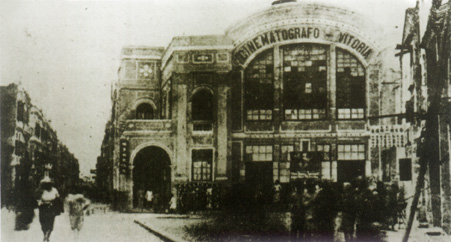 The Cinematografo Vitoria (Vitoria Cinematographer), adjacent to Avenida Almeida Ribeiro (on the left).
Photograph taken during the early Thirties.
The Cinematografo Vitoria (Vitoria Cinematographer), adjacent to Avenida Almeida Ribeiro (on the left).
Photograph taken during the early Thirties.
But, in the adjacent column, the daily clearly expresses his favouritism for the Capitol, writing:
"The construction of the new Capitol theatre — the only one which can be said to rival with the best of its kind in Hong Kong — continues at a good pace.
The scaffholding has already been removed and the interior decoration completed.
The auditorium chairs were made to order, comfortably upholstered and complying with safety precautions. Most of the construction materials were specially ordered from Shanghai.
The talking machinery as well as the electricity circuits are been presently fitted and are due to be operating by the coming month of April.
The machinery has been supplied by the well known and famous American Western Electric Co.. They are been assembled under the supervision of Mr. Coldman, an engineer of the said company.
On the construction of this theatre Mr. Alfredo da Luz and his partners have spent more than $80 000,00. Macao can there fore be proud of having a cinema which by its comfort and its excellent future venues —some in Portuguese, so it's said — will deserve from its public the greatest praises.
The first scheduled film is to be the world renown "Love Parade"."
The second film exhibited at the Vitoria was "Black Jack" with Myrna Loy and Victor MacLanglen. Despite not being a top class film it was enthusiastically welcomed by the general public who flooded to see it just because of it being a talkie.
•[XVII — II (36) 31 Agosto 1976, pp. 4-5].
The Capitol was inaugurated on the 13th of April at 14:30 in the afternoon. The Governor, Commander Joaquim Anselmo da Matta e Oliveira together with his aide, Captain Afonso Maya and the Director of the Civil Administration Services, Dr. João Pereira de Magalhães were present at the opening. Many other honourable guests took seats in the gallery while the auditorium was open to the general public.
Respectfully, the audience stood when the Governor crossed the auditorium on his way to the stage while the Municipal Band, conducted by Constâncio José da Silva, played the hymn of Maria da Fonte, so-called "Hymn of the Governors" — anyway, at least in Macao.
The "Jornal de Macau" of the 21st of April 1931 reported:
"His Excellency accompanied by the illustrious Directors of the Company went to the front of the stage and opened the curtain scene. He then proceeded to the machinery room and to the Board Meeting Room where he was offered a champagne toast by the Directors."
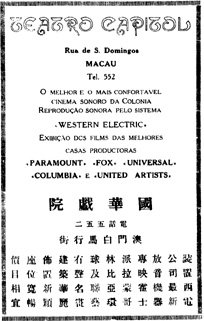 Advertisement of the Teatro Capitol (Capitol Theatre), in 1932.
"Capitol Theatre / S. Domingos Street / Macao / tel. 552 / The best and the most comfortable / cinema with sound in the Colony / Sound reproduction by the system / "Western Electric" / Exhibition of films by the best / production companies / "Paramount" "Fox" "Universal" / "Columbia" and "United Artists"
Advertisement of the Teatro Capitol (Capitol Theatre), in 1932.
"Capitol Theatre / S. Domingos Street / Macao / tel. 552 / The best and the most comfortable / cinema with sound in the Colony / Sound reproduction by the system / "Western Electric" / Exhibition of films by the best / production companies / "Paramount" "Fox" "Universal" / "Columbia" and "United Artists"
Inevitably the opening was followed by a series of speeches. Alfredo Maria da Luz was the first speaker. Here is a short extract of his delivery:
"Mr. Governor, for long now Macao wanted for a modem cinema theatre. There was not — and no one should be offended by my saying this — a construction worthy of carrying such a title.
The idea of providing Macao with such an improvement has been brooding for long. More than three years ago this idea was put forward but, unfortunately, a number of difficulties prevented its earlier implementation. Finally, today, we have achieved the outcome of our aspirations and we proudly see the product of our endeavours. We admit that this cinema is not perfect but, in a land where so many efforts become aborted, this theatre represents a great achievement of the Directors.
Having said this, the Directors trust that the public will acknowledge the scope of this commitment and requests its cooperation as well as dares to hope in the support of Your Excellency, Mr. Governor."
The next speaker was one of the Chinese partners, Vong U Chio and, lastly the Governor who "thanked them for the attention of having been invited, wishing the greatest of prosperity to the venture and progress which now benefited Macao; progress that he would be most pleased to support; and not only this one but all the others which would be as praiseworthy as this one, particularly considering the Portuguese funds which had been invested in such venture."
After a champagne toast and a short concert played by the Municipal Band, the film was projected, the audience being particularly impressed by the excellent sound quality. In fact, the sound equipment of the Capitol was the best possible for those days.
It was impossible to forget the Macao screening of Ernst Lubitsh's "Love Parade". The film had already achieved world acclaim and overwhelming acclaim in Hong Kong. From one moment to the next Maurice Chevalier and Jeanette MacDonald became international stars and popular favourites. The mood of the film could not be more convivial, the ladies seduced by Maurice Chevalier's aplomb and his provoking and sightly ironical smile, the men mesmerised by the voice and the allure of Jeanette MacDonald. The songs of the film were on everybody's lips from one day to the next.
I well remember Chevalier's lines... "I love Lizette, the smile of Mignonette, the sweetness of Suzete…", and MacDonald "The March of the Grenadiers" and "Dreams".
Which of the two theatres became the public's favoutite: the Vitoria or the Capitol?
It is difficult to give a straightforward answer because both cinemas competed, showing the best possible selection of currently available films.
The Capitol was undoubtedly more comfortable and better sound.
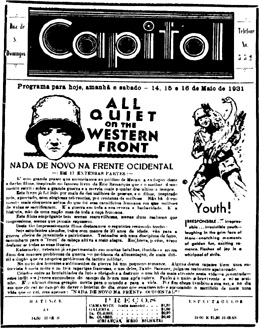 Advertisement of the Capitol Theatre for "All Quiet on the Western Front".
"Program for today, tomorrow and Saturday -- 14th, 15th and 16th of May 1931"
Advertisement of the Capitol Theatre for "All Quiet on the Western Front".
"Program for today, tomorrow and Saturday -- 14th, 15th and 16th of May 1931"
It is also true that despite the improvements made at the Vitoria the facilities were poor and unpleasant, but its film selection was top quality and when the lights dimmed the public forgot and forgave all its shortcomings.
Of that inaugural year for the talkies in Macao I must list, without attempt to be chronologically correct, some of the most memorable films shown at the Vitoria: "Four Devils" with Charles Morton, Janet Gaynor, Nancy Drexel and Barry Norton; "Sunny Side-Up" with Charles Farrel and Janet Gaynor; "The Big House" with Wallace Neery, Robert Montgomery and Chester Morris; "The Singing Fool" with Al Jolson and David Lee; "The Trial of Mary Dugan" with Raymond Hackett and Norma Shearer; "Madame X" with Ruth Chatterton and Raymond Hackett; "Rio Rita" with John Boles and Bebe Daniels; "The Vagabond King" with Dennis King and Jeanette MacDonald; and "In Gay Madrid" with Ramon Novarro and Dorothy Jordan.
The Capitol programme was equally excellent. In that memorable year of 1931 this theatre showed a series of first-rate films. I list a few, also without attempting at a chronology: "The King of Jazz" with Paul Whiteman; "In Old Arizona" with Warner Baxter and Dorothy Burgess; "The Desert Song" with John Boles and Carlotta King; "Monte Carlo" with Jack Buchanan and Jeanette MacDonald; "Morroco" with Marlene Dietrich and Gary Cooper; "Show Boat" with Joseph Schilkraut and Laura Laplante; and "Mr. Lemon of Orange" with El Brendel and Fifi Dorsey.
· [XVIII — II (39) 22 Outubro [October] 1976, pp. 4-5].
Admittedly in the infancy of such revolutionary visual technology, the public was not demanding about the integrity of the movies. The audience's greatest delight was to be engulfed by the sheer magic of listening to the 'sound' of the moving images.
Besides the already listed films some war movies exerted a galvanizing effect on the public.
First and foremost, and undoubtdely most notorious one from the early sound period, was "All Quiet in the Western Front". The Capitol sound system, then brand new and performing at its best, reproduced all the horrors of war. Many left the auditorium deeply traumatized by what they had seen. The film was an immense success, there were endless queues at the box-office and the shows were frequently sold-out.
The Capitol broadsheet, published in the "Jornal de Macau" on the 4th of May 1931, stated:
"It is with the utmost pleasure that we present to the Macanese public this superb film inspired by the famous novel of Erich-Maria Remarque, the best war document ever to be published and the most popular book of recent times.
The book was already read by more than ten million people and the film inspired by it by hundred of millions, having gained the loudest praises. It was 'raw war' with all its cruelty and barbarism. It is more than the story of a nation; but of the human race as a whole.
This epic film impresses through its extremely realistic sequences, images never to be forgotten.
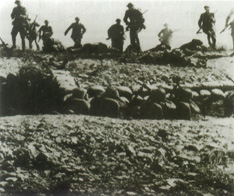
"All Quiet on the Western Front", released in 1930 by the Universal Pictures Corporation.
A film directed by Lewis Milestone with music by David Brockmamn.
The first epic war movie which shocked the Macanese audiences.
Brought up amongst clashing brutalities and forced to destroy the best thing in life — youth — (7) aspiring young men tragically fall, one after the other, in the combat fields. Paul survives to face a lonely existence. He stands as the last testimony of a generation devoid of a future worth living for. Finally, his turn arrives to honourably fall, fulfilling his duty. The day's bulletin, indifferent to the loss of yet another life and to the sacrifice of a human being simply reads: ALL QUIET ON THE WESTERN FRONT."
Such libel against war seemed to have no effect on the contemporary world power obsessed by hegemony. In May 1931, while in the Far East the film diffused its anti-belicose message, dark clouds continued to gather over Manchuria and Japan was priming its army to invade China.
Around that time a new type of war movie also made its début. The battle of the skies movies with fighting planes. This had already been attempted during the silent era but the result had been disappointing. "Wing" was recognized as a minor masterpiece, being awarded in 1929 with the Academy Oscar for the Best Movie of the Year. With the discovery of sound this originally silent movie was adapted to the new techonology. The final result was an odd patchwork of silent dialogues blended to sound sequels. Although advertised by the Capitol as one of its future venues the film was never exhibited in Macao. A very young and not yet famous Gary Cooper played the leading male role.
Those days, airplanes were still shrouded to most people in an aura of wonder. To fly was still considered as a surreal activity requiring enormous audacity and willpower. At Taipa, there was the hangar of the Naval Aviation Authorities which sheltered a single hydroplane. Invariably, whenever this plane took off, there were bewildered people following its path in the skies. I still remember when, one day strolling with friends amongst the Primary School, children from the Rua do Gamboa' School, who invariably ran and played under the Leal Senado Square arcades, I came face to face with Commander José Cabral. One of my friends whispered in my ear: —"He is an airplane pilot!" We all stared at the officer with a mixture of respect and disbelief. Thank goodness he never noticed our suddenly awkward behaviour.
Echoes of the astonishing Atlantic airplane crossing by Gago Coutinho and Sacadura Cabral followed by those of Sarmento de Beires and his companions were still deeply engraved in the memory of the people from Macao, who considered them 'titanic'. Added to these national heroes stood the 'colossal' figure of Charles Lindbergh who, in 1926, crossed the North Atlantic in a solo flight.
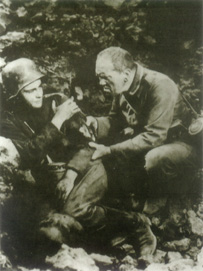
"All Quiet in the Western Front", 1930. A scene of the film, with Lew Ayres, and Slim Summerville.
A dramatic war scene extracted from the book by Erich Maria Remarque which inspired the film's plot and script.
In the beginning, the adaptation of military war planes to civil purposes, i. e. for carrying cargo and passengers, was seen with scepticism and taken as an oddity. There are still people who remember the laudatory remarks made to German science when the famous dirigible aircraft Graf Zeppelin initiated its passanger flights between Germany and the United States of America. And what about the extraordinary DOX, a fat hydroplane which was the pride of German engineering, and that could carry the unthinkable number of thirty people. When the Prince of Wales, later to become Edward VIII and Duke of Windsor, flew in that hydroplane, the British daily press (see for example, the London "Daily Mirror") inflated the event to wild sensationalism.
Just about anything dealing with aviation was bound to create great impact. Macao eagerly awaited the opening of "Wings" but, disappointingly, it never took place. As a minor compensation two other airplane war movies were shown in the colony: "Hell's Angels" and "Dawn Patrol".
"Hell's Angels", because it was the first of its kind to be shown in Macao was a tremendous success.
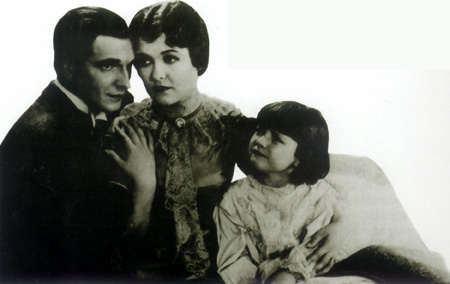
"Show Boat", a film released in 1930. A scene of the film, with Joseph Schilddkraut and Laura Laplante.
A film adapted from Jerome Kern and Oscar Hammerstein II's operetta from Edna Ferber's novel: Show Boat, and directed by Harry Pollard.
The audience raved the flight battles, the airplanes' dog-fights, the roar of the propellers and the trepidating take-offs leading the pilots to their fatal destinies. To top the bill there was Jean Harlow, with her long blond wavy hair, her insinuating dresses glamourously expressing her sculptural body, her lushious red lips and her eyes of seducing mermaid. Jane Harlow in sensuous poses and electrifying demeanour played the mean and treacherous woman enticing to doom the adventurous hero played by Ben Lyon. And while the women in the auditorium railed against the seducing witch, men stared in silence, feeling their blood hot in their veins by the presence of this mesmerizing female creature. Besides containing all the romantic prerequisites of the times and gripping war scenes "Hell's Angels"'s smashing success was also due to the technical achievements of its shooting and perfect sound tracking. The film impressed Macao and propelled Harlow into a meteoric career which would prematurely end in 1936.
•[XIX~— II (40/41) 12 Novembro [November] 1976, p.11.]
But as a war film,"Dawn Patrol" was even better than "Hell's Angels". The technical mastery of its cutting was even more elaborate, the dog-fights more realistic and involving extensive travellings and... Jean Harlow was not there to take one's mind away from the airplanes excitement. The film became the contemporary apology of the war plane fighter commandoes rendering hommage to the brave enemy — not sadists or ghastly characters grinning teeth of hatred — they are about to equally face in the line of duty. It was the exaltation of heroism, of spirit of sacrifice and dedication, of courage and abnegation, of extreme conditions and unhuman situations, of honour and honesty in mortal air battles; it was, to summarize, the contemporary recreation of the noble chivalry of the Middle Ages.
The film attempted to be representative of true facts. While on land and sea beligerant armies destroyed each other using the most atrocious and lethal devices, such as toxic gas, the air war was fought in quite a different manner. There was a tacit respect between enemies as if both parties were fighting a mortal game under a gentleman's agreement. In fact, after Baron von Richtopen, the fierce German air pilot credited with eighty victories was brought down over the Australian lines, he was buried with full military honours by the British and the Australians. The same happened with one of the most challenging British pilots credited with over forty victories killed in combat by the German fighters. His war enemies buried him in pomp, awarding him posthumous honours. As a final tribute and touch of gallantry, a German fighter plane flew over the air base of the British pilot throwing to the runway a wreath together with the boots of his deadly contender. How different from the attitude of the air pilots of the 1939-1945 Second World War. The episode I have just described was incorporated as the closing scene of "Dawn Patrol".
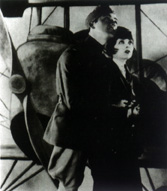
"Wings", released in 1927 by the Paramount Famous Lasky Corporation. A scene of the film, with Charles Rogers and Clara Bow.
A film adapted from a story by John Monk Sauders, and directed by William Wellman.
The leading actor of this film was Richard Barthelmess, a veteran of the silent years, who had the crown of glory of his career in this movie. Soon he would leave the tabloids never to return. Shortly before Second World War there was a remake of "Dawn Patrol", this time with Errol Flyn as main protagonist. Despite its larger budget and an elaborate technology employed in the creation of planes' raids and dog-fights, the film had less impact than its predecessor, mainly because by now the public was already familiar with this type of war plot.
These and many other films of their kind made several Macanese boys aspire to become war plane pilots. But only some followed aviation training. Amongst others I still remember the Rosa brothers (Gentil e Edmundo), Humberto Borges, Amílcar Ângelo, Artur A. Jorge, Frederico Nolasco da Silva e Armando Rodrigues da Silva.
It is necessary now to halt our narrative and focus on the events of 1931 which were to have such dramatic impact to the ensuing political history of the Far East.
Continuing the progressive euphoria which had reigned over the colony since 1927, the year started promissory of the best expectations for the increasing prosperity of Macao. The inauguration of the submarine cable, the new automatic telephone network, the recently built Post Office, Wireless and Telephones headquarters and a number of other entreprises were considered as symptoms of progressive modernization. Sound cinema was inaugurated in Macao. Two new hotels saw the light of day — the Riviera and the President — adding prestige to the territory; mainly the first where it was bon ton to go to tea, at five o'clock. Elegant villas had been built in new residential areas of Macao expanding the limits of the city to the Avenida da República (Avenue of the Republic) and the Estrada de S. Francisco (St. Francis Road).
Hong Kong was equally benefitting of a thriving prosperity, widly speculating in the Stock Exchange. The first Hong Kong Stock Exchange was in Ice House Street, the real Wall Street of the Far East. Its name became familiar to many in Macao who wildly speculated in monetary and investment fluctuations. The formidable years of 1971 and 1972 where the Hang Seng indexes reached a record high were a repeat of those of 1930 and 1931 with the difference that the volume of transactions and the capitals involved were considerably larger.
It seemed incredible that no one, or very few, wanted to face the reality that world economy had been in deep crisis since 1929. Poverty was rampant in the States, Europe and other parts of the globe, but this part of the world seemed immune from such catastrophies. The word 'Depression' which left such a sour aftertaste in the States was not even known in Macao as symtomatic of the contemporary capitalist system. In an apparent state of torpor, there was the general belief that the years of unforeseen prosperity were here to stay forever. Under this belief, monumental sums were invested by two realty companies in the construction of the Hippodrome in Má-Kao Seac, in Taipa, and the Canidrome in the Mong Ha reclamation areas, near Ilha Verde (Green Island). Competition was fierce in the anxiety to be the first to have the works finished in record time.
But beyond the haven of Macao and Hong Kong, gloomy international politics clearly contradicted the apparent bliss of these two colonies. Civil War in China, and the reappearance of War Lord factions, reached acute crisis in the first months of 1931 when General Chang Chái Tóng, in Guangzhou, declared southern China independant from the rest of the nation at a moment of great internal tension in Nanjing, then capital of the whole of China. Looming over this explosive state of affairs, Japan increasingly threatened the integrity of China as a whole. The war between both countries was imminent with the Japanese claiming the annexation of Manchuria as part of its imperial dominions.
Glimpsing at the contemporary Macanese dailies, one is astonished at the indifferent tone of the news about these massive neighbouring conflicts. Macao newspaper articles dealt more with minor local accidents than with international catastrophes. It is hard to trace a note of alarm or a hint of disquiet.
•[XX-- II (43) 17 Dezembro [December] 1976, p.5].
But suddenly interrupting the wave of optimism which had prevailed undisturbed in Macao for the last few years, there occurred a strange incident which many foretold as a warning of disaster to come.
This sudden 'act of God' was the typhoon which hit the colony on the 19th of April 1931, exactly the day after the opening of the Capitol and on the opening day of "Sunny Side Up" at the Vitoria.
Typhoons are uncontrollable calamities which usually occur at the beginning of summer. Very rarely do they climax without a minimum forewarning. Usually, it is possible to sense the approach of a typhoon even without looking at the barometer or reading the metereological report in the news, as the temperature abnormally rises, the sky and the weather in general abruptly change, and the sea becames dead flat with the fishermen gather their vessels in the Porto Interior (Inner Port). And if in 1931 there were no weather satellites or radio meteorogical bulletins every fifteen minutes, the observatories of Macao, Hong Kong and Silver Island timely broadcasted about the stormy skies of the China Sea.
It is also common to sense the sudden approach of strong winds creating stormy tidal waves and gusty westerly gales making hazardous the ferry crossings between Macao and Hong Kong. These are the so-called seack-vús which damage the junks and the fishing boats but which rarely cause any human casualities.
But there is no memory of a hurricane ever catching the city totally by surprise, neither with such destructive impetus.
I can no longer remember if it had been a wet morning, but I vividly recall extremely dark clouds rapidly assembling late afternoon and by 7 pm. torrential rain hitting the colony. The downpour turned into diluvian rain accompanied by a tremendous thunderstorm. Lightning furiously tore through the sky, the lightning only making visible the compact darkness of the clouds and the thick veil of water which incessently gushed over the territory. To make matters worse, the strong wind became a real typhoon, the usually calm sea surface becoming an uncontrollable succession of massive waves.
In hours desolation invaded the town. Trees were torn, their roots out-by up in the air, embarkations sunk with their crew on board with great numbers of casualities, the gunboat Pátria and the speedboat Macau were damaged, houses collapsed, and if we still recall well, here and there a number of fires ensued.
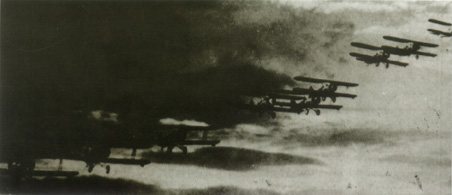
"The Dawn Patrol", released in 1930 by the First National Pictures Incorporated. A air squadron.
A film adapted from a story by John Monk Saunders, and directed by Howard Hawks.
I was caught totally by surprise with my parents and brothers, while watching a movie at the Vitoria. The film was interrupted shortly after its beginning. The thunderstorm was so loud that panic spread in the audience and most people started leaving the theatre. Of the film I can only remember the first accords of the melody "Sunny Side Up" sung by Janet Gaynor. Suddenly the film was off and the lights of the auditorium were on. We gathered in the theatre hall observing the dowmpour flooding down the Rua dos Mercadores towards Avenida Almeida Ribeiro. I don't know how but my father got a cab — one of the very few which then existed in Macao and belonged to the parking garages.
We were drenched jumping into the cab. The driver was excellent in controlling the vehicle with calm and dexterity despite the impenetrable blinding downpour and the gushing windblows which hit the car, giving the sensation of lifting it from the road surface. Without exaggerating I can say that by the time we reached home we were almost in a state of shock.
The following day the town looked devastated. Particularly impressive was the retaining wall of the Praia Grande promenade, still as it was before the reclamation works which would alter forever its configuration. It was littered with the debris of junks, and repulsively swollen bodies of dead pigs and dogs brought from unimaginable places.
Chinese superstition, which sees in natural phenomena a forewarning of political and economic events, aired views that the bonanza of the past years was about to end and that prosperity would come to a halt. In reality, the facts soon proved that these apprehensions were justfied.
The town was cleaned of all the mess and chaos and soon normality set the pace of life again. The typhoon, widely debated for days after the catastrophe, eventually fell into oblivion. Town chat centred in hotter topics such as the continuing rise of the Hong Kong Stock Exchange index, and the competitiveness of the Hippodrome and Canidrome works which were reaching their final stages.
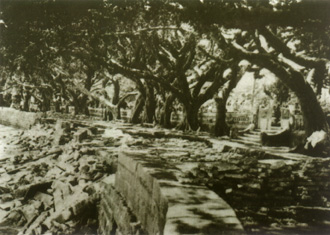
The damaged retaining wall and promenade of the Avenida da Praia Grande after the great typhoon of the 19th of April 1931.
The President Hotel is pompously renamed Grand Central Hotel, later to be commonly known as Hotel Central. Its major attraction were the gambling rooms with fantan and ku-sek playing tables thus pretending to recreate a casino atmosphere. This was seen as a great asset towards the modernization of Macao. The 16th of June "Jornal de Macao" reported with great excitement the inauguration of these new gambling rooms.
In a torrid July evening when the beach huts of the Porto Exterior (Outer Port) and the Tai-Páns Beach where bustling with activity, and paper kites and sarangons competed in cruising the skies, a memorable event took place in a far-away place with would drastically change the course of events in Macao. The fact was to pass unnoticed in the press of Macao. It was the assassination of the Japanese Captain Nakamura in a remote spot in Manchuria. This killing would remain shrouded with doubts about the identities of its true prepertrators, if Chinese, Manchurian or eventually Japanese agents had been secretly ordered to unleach the conflict.
Japan violently protested against this aggression. China excused itself from all responsibility. The militant Government of Japan carefully orchestrated to the international press and political circles a campaign justifying its imminent invasion of Manchuria and frontal attack on China. The momentum was right for such a move as the political cohesiveness of the Middle Kingdom was split amongst a series of War Lords who openly defied the central Government with headquarters in Nanjing. General Chang Chai Tóng, for instance, had in Guangzhou already declared the autonomy of Southern China from the central Government. The military feebleness of China was obvious, exhausted by successive civil wars and devoid of economic stability.
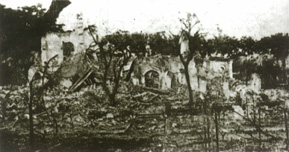
The ruins of the Flora Pavilion after the explosion of the 13th of August 1931.
The miraculous image of Our Lady can be seen between the upper branches of the tree on the right side against the background wall of the mined structure.
I believe that no one in Macao, or in Hong Kong, for that matter, understood the hypothetical catastrophic consequences of the incident of the 31st of July. Spirits ran high. During the last days of that month, the most important topic of conversation at the bridge and billiard tables of the Clube Militar (Military Club) had been the imminent closing of the Capitol due to managerial conflicts. This fact was the cause of much distress, as the public would be deprived of one of its favourite sources of entertainement, meaning that the Vitoria would remain the only cinema in town without competition. Once again this old theatre was the only one to cinema to the public of the colony, only this time, the movies had sound.
August came as an exceptionally hot month.On the 13th of the month, shortly after 5.30 am. a tragedy occurred in Macao: the Paiol da Guia (Gunpowder Storerooms of Guia) exploded.
•[XXI — II (44) 6 Janeiro [January] 1977, pp.2-3].
Dawn rose clear but stifling. The previous night had been breathless and the few electrical fans which existed in Macao had swivelled non-stop. The crack of dawn heralded that the heat would remain implacably unabated for the day.
It was 5.35 am. Suddenly, a brutal bang shook the whole city, like a monstrous roar errupting from the entrails of the earth. A considerable section of the Gunpowder Storerooms of Guia had exploded. The Gunpowder Storerooms were situated at the bottom end of Jardim da Flora (Flora Gardens), not far from the elegant Summer Palace of the Governor which was then occupied by a creche. The explosion spread a rain of fire and metal shreds over a radius of five hundred meters. The violence of the detonation was such that beyond the limits of the accident centre all doors and windows were thrown ajar, shattering the windows. The windows of our house in the Estrada de São Francisco greatly suffered from the explosion.
The explosion tore trees from their roots, demolished houses and sections of the city walls, catapulted massive boulders which landed on rooftops and crashed against walls of houses. Death and destruction were everywhere. Bullets and ammunition had also been blasted over a large area. The air was filled with screams of agonizied bodies and wounded people. The scene was one of chaos and desolation. Those who had luckily survived unblemished wandered aimlessly, sitting here and there on the rubble, in a state of total shock. The sulphurous smell of the atmosphere was pierced by hysterical shrieks and convulsive crying.
The city's fire brigades and military forces immediately rushed to the local of the disaster, fighting hard to contain the fire which consumed some of the inner chambers of the Gunpowder Storerooms. There was the imminent danger that another explosion could take place as at least one more storeroom was full to the brim with ammunition, but finally the fire was contained and later extinguished, thus saving Macao from further blastings of unforeseable consequences.
Then, amidst the débris and rubble of the smouldering ruins where the reticent smell of sulphur was gradually becoming impregnated with the stink of coagulated blood, begun the arduous task of recovering the dead, salvaging the trapped and treating the wounded. Statistics mentioned twenty-one dead, twenty-four seriously injured and about fifty other casualities who were given hospital leave that very day. But in fact the number of wounded was much larger, taking in consideration that many more sought direct assistance from private practioners and doctor friends, rather than going to the overcrowded emergency services of the city's three hospitals.
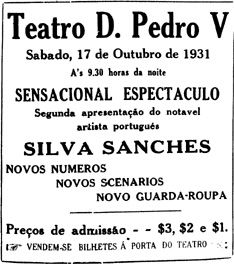
Advertisement of the Teatro "D. Pedro V" ("D. Pedro V" Theatre), in 1931.
"D. Pedro V Theatre / Saturday, 17th of October 1931 / At 9.30 in the evening / Sensational Show / Second performance by the notable / Portuguese Artist / SILVA SANCHES / New Acts / New Sets / New Costumes / Admission prices — $3, $2 and $1. / Tickets are sold at the Theatre's entrance".
And if the number of dead and wounded was comparatively small compared with the scale of the explosion, this was because in the 1930s the area around the Flora Gardens was sparsely populated with only a few villas, some gardens and large tracts of undeveloped land. If the same explosion was to happen now, the scale of the disaster would be terrifying.
The devout Catholics of Macao attributed the low number of casualities to the miraculous protection of the Virgin Mary, which is usually invoked when a catastrophe hits in the City of the Holy Name of God. Oddly enough the cindered branches of a burned-out tree nearby the entrance to the Gunpowder Storerooms clearly show in a photograph the miraculous apparition of the Virgin Mary.
Five of the dead were Portuguese, one was an African soldier and the remaining fifteen were Chinese. The Portuguese were the First-Sergeant António de Souza Vidal, who died minutes after arriving at the emergency services of the Hospital de S. Rafael (St. Raphael's Hospital); the Public Works controller Henrique Círiaco da Silva; his nephew, the student João Córdova; the eleven year old Natércia Correia Duarte; and a baby Maria Augusta da Silva, daughter of the Chief Constable Carlos A. da Silva, who was crushed under a wardrobe. The African soldier named Reina was No.4 756 of the 51st Companhia Indigena de Moçambique (Indigenous Company of Mozambique). Most of the fifteen Chinese belonged to the same family named Ung. Kam Wong Cheong, ex-director of the Finance Department of the Chong San District, also perished together with his wife and brother.
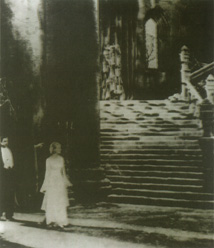
"Dracula", a film released in1931 by the Universal Pictures Corporation. A scene of the film, with Tod Browning and Bela Lugosi.
A film adapted from the play: Dracula the Vampire, dramatised by Hamilton Deane and John Balderstone from the novel by Bram Stocker: Dracula, and presented by Carl Laemmle.
An operatic scenario creating the eerie atmosphere of one of the first great horror stories of the 'talkies'.
The cause of the explosion was thought to be the high temperature of the storerooms associated with insufficient ventilation. The areas which suffered most with the explosion were the Flora Garden and the District of Lông T'in Ch'uen. The cost of the damage was extremely high. The Summer Residence of the Governor (then a nursery) and six private houses were raised to the ground. Fifty-six others were partially damaged, some so structurally unstable that they were considered uninhabitable. The number of partially destroyed buildings and residences beyond the radius of the catastrophe was never ascertained but there were many with cracked walls, partially collapsed roofs and ceilings, broken furniture, irretrievably damaged artworks and personal items, shattered glass, etc.
The funeral of the Portuguese who died from the explosion was on the following day, leaving from the Hospital de São Januário. Huge crowds gathered to pay their last respects to the deceased in the largest collective manifestation of grief that Macao had ever seen. A special delegation of scouts came from Hong Kong. The Liga Portuguesa (Portuguese League) and the Associação Portuguesa de Socorros Mútuos (Portuguese Association of Mutual Help) from Hong Kong were represented by Mr. Antonio Ferreira Batalha, the Chief Assistant of the Repartição do Expediente Sínico (Department of the Chinese Bureau).
The burial procession of the dead Chinese left for the Chinese mainland from the Kiangwu Hospital with similar popular manifestations of grief and commiseration. Wailing and sorrowful crowds gathered along the way to see the funerary cortege, from Estrada Coelho do Amaral to the Border Gates.
The terrible event left unforgettably painful memories in all those who saw the extent of the damage. And if the Oriental superstition was already pessimistic with the outcome of the 19th of April typhoon, the explosion of the Gunpowder Storerooms of Guia came to inflame strong suspicions that difficult times were to asssail the colony in the near future.
But life must go on and, once again, mournful Macao resumed its normal way of life. People made an effort to look forward and heal the sorrowful scars of the disaster. The month of September promised a few spectacular events, along with the inaugurations of the horse races at the Hippodrome and the dogs races at the Canidrome. Recent events in China seemed to be the least of worries for the Macanese. The Civil War fast spreading throughout that vast country, continued to remain largely unnoticed in Macao and was certainly no cause for alarm amongst the local people. In fact, the local press rarely reported about international events, and much less remarked about the abnormal concentration of Japanese troops in Korea and all along the trans-Manchurian railway which was now under their control.
On the 27th of August the "Jornal de Macau" closed its doors after gaining further notoriety for scrupulously investigating and follow-up the Gunpowder Storerooms' explosion, during its last days of circulation.
The 1st of September saw the publication of the first number of"A Voz de Macau" — the first name given to the daily presently entitled "Notícias de Macau". Henrique Nolasco da Silva was its director and Captain Rosa Duque — The 'soul' of the extinguished "Jornal de Macau" — its chief editor.
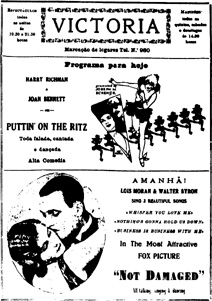
Advertisement of the Cinematógrafo Vitoria (Vitoria Cinematographer), in 1931.
"Shows / every / evening / at / 19.30 and 21.30 / pm" VITORIA "Afternoon[Shows] / every / thurdays, saturdays / and Sundays / at 14.30 / pm"
On the 6th of December the first horse races in Macao inaugurated the Hippodrome of the "Macau Jockey Club", on the Areia Preta (Black Sands) District. Macao was becoming more cosmopolitan and elegant. On the members' section gentlemen with exquisitely tailored suits socialized with ladies in extravagant toilettes. Now that the colony could boast of having race horses such as in Hong Kong, Shanghai, Singapore and Europe, it could be said that at last the rhythm of the city was catching-up with other modem metropolis.
To the delight of all the movies' enthusiasts the Capitol theatre re-opened on the 12th of September with Harold Lloyd's "Hard Feet". Once again Macao could say that the city had two cinemas with sound.
•[XXII—II (45/46) 29 Janeiro 1977, p.10].
After Lloyd's hilarious comedy was shown "Skippy", an adolescent's movie with a cast headed by Jackie Coogan and Mitzi Green and, after that, "Resurrection", inspired by Tolstoy's novel, with John Boles and Lupe Velez in the major roles.
"Resurrection" was a heart-breaking movie and plenty of tears were shed by the public. Capitol had an auspicious restart. The chairs were as comfortable as ever, the programs' selection carefully looked after, the sound system in top condition, and the public in a joyous mood. But the new management of the Capitol wanted to be more progressive than its predecessors. There were plans to expand the range of activities to theatre performances and music concerts.
In Macao life was taken without worrying too much. The recently inaugurated horse races, the cinema outings and all the other pastimes that this quiet city, abundant in social events, constantly promoted diverted the peoples' minds from the increasingly threatening development in international affairs.
Meanwhile, the follow-up by the Japanese press of the Nakamura incident had reached unprecedented hysteria. The Chinese Government was at a loss, not understanding why the whole incident was being totally blown-out of proportion.
The Hong Kong dailies of the 18th of September, while speaking of the horrors of Civil War in China, only lightly mentioned Japan's increasingly menacing turn of events. That same night, Artur Tristão Borges, one of the best journalists writing about contemporary China for the "A Voz de Macau", wrote an article which mentioned:
"While the supreme headquarters [meaning, the Central Goverment of China] further ignites brotherly antagonism [meaning, the Civil War in China], foreign powers [meaning, Japan] escalate their armaments' potentials and mobilizing their military forces in the hope to take the maximum of advantages from the Nakamura accident. These unconfirmed rumours created widespread panic in the Shanghai gold market.
Meanwhile, the Foreign Affairs Minister, Dr. C. T. Wang, declared to some Japanese reporters that the Nakamura incident would be resolved in the best and fairest possible terms, after a full investigation of the facts, and considers inexplicable the most recent over-inflated Japanese outcry about this incident."
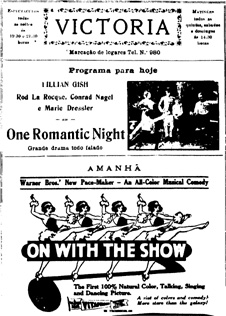
Advertisement of the Cinematógrafo Vitoria (Vitoria Cinematographer), in 1931.
That same night there occured the so-called 'Mundken incident'. Along a stretch of the Southern Manchurian railway line, near a bridge some miles distant from the strategically important city of Mundken there was a hard clash between Chinese loyalists to the Central Government and Japanese troops. The Japanese immediately accused the Chinese as being the initial aggressors, although it has been later proved that the incident was deliberately provoked by the Japanese in order to be able to justify a future invasion of Manchuria. In fact, the incident was easily controlled by the Japanese who were much better prepared for clashes and easily disbanded the ill-equipped Chinese. The Japanese thought that the incident would be the prelude for an easy military en masse operation, but China, despite losing ground and withdrawing with massive losses, held strong. The Japanese brutal aggression faced unexpected troubles. Although strongly divided into civil factions, the Chinese were unanimous in their patriotism. In all major cities in China, students and workmen joined forces and openly marched, requesting the whole country to join forces against the common enemy. This massive appeal had its results. The South quit from its pretentions of autonomy and joined forces with the Central Government, sending its elitist Nineteenth Army north to Shanghai ready to fight the enemy. While these events took place Macao remained in its beatific nonchalant lifestyle. Some 'hicups' were felt when there was a joint gold rush in the Shanghai and Hong Kong Stock Exchanges and the trade indexes dropped value. But rapidly this slight fall was regained and both Stock Exchanges leveled their trading rates. Mukden was still felt to be a minor incident easily patched with Japan. So, in Macao, after a minimal fright, joy and confidence were back in power.
During those tense days which would later be recognized as the turning point of Far East economic stability, Macanese society was much more worried with the final preparations for welcoming the Portuguese actor Silva Sanches, who according to the "A Voz de Macau", was bringing "a jist of the Portuguese 'soul' which deserves well to be cherished and encouraged, as it has always been throughout the world."
Arriving on the 22nd of September he was welcomed with the usual enthuiasm and sympathy which are trade marks of the Macanese community. He was the target of numerous local press releases. The extract of an article imbued by lyricism in the "A Voz de Macau" of the 24th of September stated:
"[Silva Sanches] is unparalleled as a singer of Portuguese songs and 'stylized fado',and expert dancer of the Charleston and Fox […].
Silva Sanches enchanted and thrilled with the mellow Neapolitan song "Aquele foi com as rosas!" ("That was like roses!")[…].
It was an admirable melody, each word of its tune being like a rose, a love rose, the headdress rose of a sweet maiden, of a dream lullaby."
I have only kept a faint memory of the singer, my impression of the artist relying more on the commentaries by those who were close to him during his stay in the colony. Despite his extremely enjoyable on-stage delivery and being a most talented artist, Silva Sanches was an arrogant character who strolled around town looking down on people as if he, because of his performance skills, was superior to them all. He spoke like a pompous academic delivering a lecture, and as if he were the representative of all the cultural glories of the Portuguese theatre. He quoted Almada Negreiros, Rey Collaço, Leal da Câmara and Júlio Dantas as if they were his close friends.
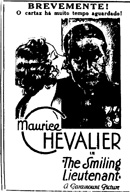
Advertisement of the Teatro Capitol (Capitol Treatre), in 1931.
"Soon! / The venue eagerly waited for! / Maurice Chevalier / in / "The Smiling Lieutenant" / A Paramount Picture".
He made enemies from the moment he arrived. His petulance and feigned superiority at the Clube Militar and Grémio Militar became intolerable to many of their members. From the moment he arrived he assumed that no Macanese had theatrical culture and that every single person had to bow to his opinions. He certainly forgot about the performances and concerts at the Teatro D. Pedro V (Dom Pedro V Theatre) where tail coats or 'smokings' were obligatory.
Notwithstanding his difficult personality, his opening night at the Capitol, on the 3rd of October was a complete success. The theatre was full, the public sang along with the most popular tunes and laughed a lot his jokes. The thirty beautiful sets and the extremely chic clothes which he brought with him from Portugal greatly contributed to the success of the show. He was enthusiastically applauded and his following venues at the Teatro D. Pedro V were equally successful. The large Portuguese community of Hong Kong invited him over to give a few performances. These were also unanimously acclaimed. He stayed in Macao for a season. Although when he returned to Portugal people were sad to see a big artist leaving, many were pleased to see him go as he hadn't made a single friend.
The Capitol maintained an excellent film selection. In October it showed "Vagabond King" with Jeanette MacDonald and Dennis King, immediately followed by "Dracula" with Tod Browning and Bela Lugosi.
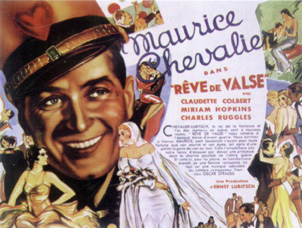
A French promotion poster of "The Smiling Lieutenant", released in 1931 by the Paramount Publix Corporation.
A film adapted from the operetta by Leopold Jacobson and Felix Dorman: A Waltz Dream, directed by Ernest Lubitch, and with Maurice Chevalier and Claudette Colbert.
The Macanese public was strangely mystified with the odyssey of the noble vampire. Again and again the Capitol was sold out with a public eager to be terrified for one-and-a-half hours. Bela Lugosi became an instant idol. This spooky film was a worthy following of Lon Chaney's mastery.
Not wanting to be second on the run of successes, the Vitoria was selecting equally good movies. It showed a number of films staring José Mojica who immediately became fashionable. He had a particular latin charisma different from all previous heroes, and the youngsters soon learned how to hum his songs to dancing the tunes.
The Sino-Japanese war was still remote from Hong Kong and Macao. But an anti-Japanese feeling was decisively in the air and in the Hong Kong newspapers there were increasingly frequent reports of incidents between Chinese and Japanese residents in the British colony.
But Macao was involved in yet another tennis tournament, this time organized by the Direction of the Campo Desportivo Escolar (Schools' Sports Field), under the presidency of Lieutenant Filipe O'Costa. This event was particularly brilliant in the matches played by students.
Playing 'singles' were: José Vidigal, Fernando Silva, Damião Rodrigues, José Borges, Álvaro Silva, Manuel da Silva, Luís Lobato, José Boyol, António Nolasco, José de Almeida, Fernando Albuquerque, Pedro Ângelo, Leonel Rodrigues, Énio Ramalho, Frederico Nolasco and João Carreiro.
The 'doubles' pairs were: José Borges-Manuel da Silva, Damião Rodrigues-Álvaro Silva, Luís Lobato-Francisco Garcia, José Vidigal-António Nolasco, Fernando Silva-Elgar Basto, José Boyol-José Almeida, Pedro Ângelo-Fernando Albuquerque, Énio Ramalho-Frederico Nolasco, and Leonel Rodrigues-José de Almeida.
•[XXIII — II (47) 16 Fevereiro [February] 1977, p.5].
During the last months of the year the Vitoria and the Capitol both exhibited a series of musical movies. Most were second rate movies mass produced by the Hollywood studios which made no history. But the Macanese public were not great connoisseurs of these kind of films and excitedly followed both series with enthusiasm. The 'chromatism' of sound was still a great attraction, this time associated with the luxurious sets, the rhythmic precision of the 'chorus girls' and the continuous succession of sung and danced choreographies.
Irving Berlin's melodies soon became widespread throughout the world and popular in Macao. After his tunes in Harry Richman's "Putting on the Ritz", many more reached popularity. "With you", "Singing a Vagabond Song", "There's danger in your eyes" and "Cherie" are among his most tremendous hits.
Amongst other musical successes of the season, the Vitoria showed "Not Damaged" with the great song hits "Nothing's Gotta Hold Us" and "Business is Business with Me", and Lois Moran and Walter Byron in the cast; and "On with the show" with astonishing sequels of tap dancing and frantic Charleston. Late November was the turn of "Happy Days", a musical fantasy with the best actors of those days: Charles Farrell, Janet Gaynor, Victor Mclaglen, Edmund Lowe, Marjorie White, El Brendel, Warner Baxter, Dixie Lee, Avid Rollins, Will Rogers and Frank Albertson. The film was packed with love songs, amongst others, "More", "Minstrel Memories", "Crazy Feet", "A toast to the Girl I Love", "I'm a diet of love" and "Happy Days", the inaugural hit of 1932. The following musical movies would be "Golden Calf" with Sue Carol with a "hundred dancing girls and fifty Broadway stars," and "It's a Great Life" with the Duncan Sisters (Rosetta and Vivian) famous for their duets "I'm Following You", "I'm Sailing on a Sunbean" and "Hoosier Up".
All these films were made in an America already under the throbs of the 'Depression', their fantasies being a relief to the harsh reality of the times. The crowds rushed en masse to the cinema's dark rooms trying to forget the disastrous economic impact of the crash of the New York Stock Exchange, in 1929. Although in the States these movies became super-successes of a nation who sought palliatives and alternatives for the afflictions of everyday life, in Macao, the public filled the auditoriums in the constant pursuit of happiness.
With the flood of musical movies in Macao, there was a parallel demand for the records of the favourite actors' biggest hit songs and with these the increasing sale of gramophones and record-players. The "Casa Bruswick" ("Brunswick House") was the specialist shop where music enthusiasts flooded to buy records and sound-playing equipment. It used to be in Avenida Almeida Ribeiro, and had its most prosperous times during the early 1930s.
In December, the Vitoria exhibited a film which, despite being packed with delightful songs, cannot be classified as a musical movie. Entitled "Gay Madrid", with Ramon Novarro and Dorothy Jordan in the leading roles, it was a romantic and soppy story destined for the frail hearts of sentimental women. Novarro, a 'latin lover' superstar from the silent years, continued to be increasingly popular during the early talkies. "A Voz de Macau" did not hide having a 'soft spot' for the actor. An article comments:
"Novarro, accompanied by a fifty-voice chorus, admirably sings Xavier Cugat's melodies: "Santiago", "Let me love you, love" and "Dook Night". The programme is completed with the tunes "Smile Comrades", "Into my Heart" and "Wine, Women and Song".
And although Ramon Novarro's appeal would increasingly dwindle amongst his fans during the following years, Cugat's renewed repertoire of musical hits would continue unchallenged until the end of the 1950s.
Besides the wave of musical movies, the Vitoria presented other types of international box-office successes. "White Shadows in the South Seas", a story in a paradisiac island in the Polynesia, with Monte Blue and Raquel Torres; "The Bishop Murder Case", one of the greatest detective movies of all times, with Basil Rathbone and Leyla Hayams; and "The Big House", already commented on by us, were the most popular films of the season in Macao.
"The Big House" is an unqualifiable story; perhaps one of the most thrilling and emotional cinematographic documentaries of a prison rebellion. Wallace Beery, Chester Morris and Robert Montgomery are all equally brilliant. Beery's excellent role of brutal and sadic prisioner was considered so impressive by Metro-Goldwyn-Mayer to be elected to the category of top star.
The Capitol did not lag behind in its choice of films, carefully selecting its seasons' programmes. From its musical selection the the ones which drew most public were: "Monte Carlo" with Jack Buchanan and Jeanette MacDonald, and "Paramount on Parade" with Charles (Buddy) Rogers and Lilian Roth singing "Any Time the Time to Fall in Love" and Jack Oackie and Zelma O'Neil singing "I'm in Training for You". Sari Maritza in "The Greek Street" was an exciting surprise. The film was crammed with lovely songs such as "I've a little love song", "The Undress Parade", "Share your lips with me", and delightful tunes such as "In old Tijuana", "Sentimental Fool", "Funiculi Funicula", and "Monte Carlo".
After "Love Parade", Maurice Chevalier's two latest movies: "The Innocent in Paris" and "The Smiling Lieutenant" — this last one with the upcoming Claudette Colbert— confirmed the charm of his extremely sauve style.
Another sensation of the Capitol season was a new actress, a talented cold seductress of enigmatic and exotic profile, a woman with an alluring and smooth voice, a tall, slender body, and sculptured legs. Her name was Marlene Dietrich, making her début with a role inspired by Mata Had, in a movie called "Dishonoured". Her presence was rivetting. Unforgetable was the movie's last scene when she played a classic piano piece before being taken to be shot by a firing squad. A week later she reappeared at the Capitol screen in "Morrocco", superbly acting with Gary Cooper and Adolph Menjou. Marlene had become an idol!
The Capitol, in its attempt to be more than a movie theatre decided to add a live number before the triumphal comeback by public demand of "Love Parade". Starting the programme they presented an American variety group called "Nellie Farren's Whoopee Girls", an all female ensemble which performed nightly for a week. All Macanese youngsters were wild with excitement. The starlette girls were frequently bombarded during their tap dancing act by ticket messages from playboy admirers requesting rendez-vous. The boys crowded in the Travessa dos Anjos eagerly waiting to spot them leaving the theatre after the show.
Not so frivolous was the opening evening of the Schneider Trio on the 22nd of November. For the first time in Macao, the Capitol presented a concert with musicians of world renown. The Trio had Baron A. Vietenghoff, playing piano; Remja Waschitz, violin; and Wolfgang Schneider, cello. They played works by Mozart, Rameau, Chopin, Skriabini, Purcell and Arensky. It was a memorable soirée of classical music, unfortunately not duly appreciated by the general public which did not fully respond to the effort of the theatre's management to bring to the colony's some of the best contemporary interpreters of classical music.
•[XXIV — II (48) 12 Março 1977, p.2].
Cinema was not the only source of entertainment in Macao. Horse races were gaining increasing support from its members and supporters. Whenever there were horse races, the "Sui Tai", "Sui An", "Cheung Chaw" and "Tai Hing" sea ferries from Hong Kong to Macao were full to the brim.
The dog races' track and viewers' stands were almost finished. On the 10th of November, the "A Voz de Macau" reported that one hundred and seventy dogs were being kept in two hundred kennels waiting for the race track opening day. It stated:
"The race track plus the running dummy-rabbit rail is almost finished. In a few days the greyhounds will start practising for the big opening. These dogs needs a preparatory training period of three weeks before the first race.
The stand for one thousand five hundred people is almost finished. There are workmen working at it day and night, to have it completed as soon as possible.
Once again, on that gorgeous autumn day, the trust of Macao in its bright future seemed unshakeable. The cost of life was extremely inexpensive. For instance, the "Beatriz Berta de Sousa Company", sited at the Rua Horta da Companhia no. 10 was promoting olive oil at the exceptional cost of $1.30 per litre, and the "Macao Store", a food department store in the Avenida Almeida Ribeiro had an advertisement in the "A Voz de Macau" boasting that "This year the price of ice is 1 avo for every pound of weight".
The bookshop "Oriente Comercial Limitada" ("Comercial Orient Limited") had for sale the latest literary novelties: Lourdes by Brito Camacho, Hollywood capital das Imagens (Hollywood: Capital of Images) by António Ferro and O Homem que matou o Diabo (The Man who killed the Devil) by Aquilino Ribeiro.
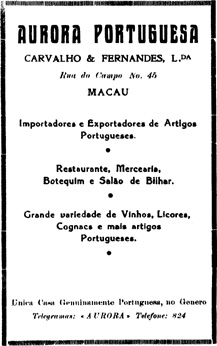
Advertisement of the "Aurora Portuguesa".
"Carvalho & Fernandes, L. da / Rua do Campo No.45 / Macau / Importers and Exporters of/Portuguese Goods · Restaurant, Grocery, /Bar, Billiard Room. • Great variety of Wines, Liquers, / Cognacs and other / Portuguese Goods • The Only Genuinely Portuguese Store ofits Kind / Telegrams "Aurora" Telephone: 824"
The Outer Port was not yet a total delusion. National steamships such as the "Chinde" and the "Gil Eanes" anchored, bringing military contingents and political exiles. On the wooden mooring alongside the Cube Náutico (Naval Club) berthed the "Sagres" of the Macao-Timor Line and the Macao-Mozambique Line. The civil servants coming from or departing to metropolitan Portugal, or on temporary absent leave travelled from Hong Kong, either on the "Porthos" of the Messageries Maritimes or on the "Derfflinger" from the German Lloyd.
Those longing for succulent and hearty Portuguese cuisine went to the "Aurora Portuguesa" or the "Fat Siu Lau". The best place for a glass of fresh milk or assorted fruit juices was the "Leitaria Macaense" near the Capitol. The tastiest kai si fán (rice chicken) in town was to be had at the "United States" restaurant on the ground-floor of the "Hotel Central", just opposite the Vitoria. The best dancing was the "Hou Heng Club", on the sixth floor of the same hotel.
In the tennis Students Championship the final winners where Manuel da Silva in 'singles' and the team Jose Boyol-José Almeida in 'doubles'. The football aces were the eleven players of the Sociedade União Recreativa. With hockey, Lieutenant Filipe O'Costa was patiently training what would be one of the greatest Macanese teams. In December, the Royal Yatch Club of Hong Kong organized a spectacular boat race, the fifteen competitors anchoring offshore in the Praia Grande bay giving to its panorama an unusual splash of activity.
The Hong Kong Stock Exchange's bustling trade continued thriving, with shares and indexes still rising. Big shots from Macao had an active role in this financial market and were incessantly eager to make quick profits.
In Manchuria the ravages of war were escalating. Despite successive victories the Japanese faced mounting opposition from the Chinese troops, mainly from the military forces commanded by Tsang Hsuh Liang, also known as the Young Marshall, being the son of the famous warlord Tsang Tso Lin. By December, most of Manchuria had fallen to the Japanese. The League of Nations seemed powerless to stop the invaders, despite having taken multiple resolutions.
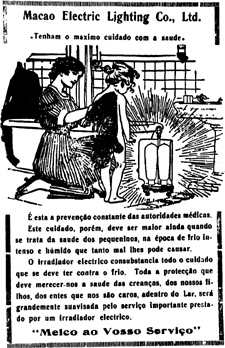
Advertisement of the "Macao Electric Lighting Co., Ltd."
"Have the greatest of care for your health" / This is the constant reminder of the health authorities. / Therefore, this care should even be greater when / looking after the health of the little ones, in times of intense cold / and humidity, which such harm may cause them. / The electric radiator assists with all the care / to be taken against the cold. All the protection that / children's health requires, that of our children, / of our loved ones in our homes / will be greatly assisted by the important services rendered/ by an electric radiator. / "Melco at Your Service""
The Japanese had so far kept away from central China. Japanese initial plans included only the annexation of Manchuria not contemplating the invasion of the whole of China. It was only when the situation escalated to impossible compromises from boyh sides that the Japanese miltary powers relentlessly expanded. China, feeling impotent to contain Japanese superiority, retaliated economically. The Chinese Government promoted a vast campaign against all Japanese products and supported mass demonstrations against all imports from that Country. In Hong Kong the troubles escalated. Japanese residences and commercial premises became targets of protests. There was looting and arson, many casualities and, in some circumstances, massacred Japanese. In Macao, the dentist Wade, the only Japanese citizen living in the colony, was constantly protected by police security.
Japan openly expressed that the Hong Kong incidents against Japanese citizens were considered by the Empire of the Rising Sun as intolerable provocations. The Japanese Naval forces moved to the Yellow Sea and the South China Sea. Destroyers and gunboats patrolled the Yangtze River without interefering with the normal course of events. But, in Tianjin, the Japanese Concession opened fire on the Chinese town district in order to contain an insurrection from the populace.
The League of Nations continued to convene endless meetings without achieving any concrete results or imposing any real sanctions against Japan. China then understood that the inevitable was about to happen and, despite being dismembered by its internal political clashes, prepared itself for the worst. The Sixty-Second and Sixty-Fourth Divisions join the Nineteenth Army under the command of General Tsai Tin Kai, near Shanghai.
Worried about the impact of the war on their economy, the British implemented their diplomacy with Japan in an attempt to prevent further disasters. The United States of America resorted to massive naval operations in the Pacific. This was happening ten years before Pearl Harbour.
This was the disquieting international news of the last days of December 1931. But in Macao, all was forgotten by the social events which culminated in the cosmopolitan and glamourous inauguration of the dog races on the afternoon of the 26th.
The year ended with sad news. On the morning of the 31st of December news spread in town that Manuel da Silva Mendes -- a great lover of Macao and all Macanese, a man of a refined, intellectual and cultivated personality whose literature --essential to all those who wanted to know the 'heart and soul' of the land -- had died the previous night at his residence in Estrada do Engenheiro Trigo. **
Translated from the Portuguese by: Fiona Sanders
XI — II (26) 27 Marco [March] 1976, pp.2 and 7.
XII — II (27) 14 Abril [April] 1976, pp.4 and 5.
XIII — II (28) 4 Maio [May] 1976, p.2.
XIV — II (29) 20 Maio 1976, pp.4-5.
XV — II (30) 12 Junho [June] 1976, p.4.
XVI — II (35) 20 Agosto [August] 1976, p.5.
XVII — II (36) 31 Agosto 1976, pp.4-5.
XVIII — II (39) 22 Outubro [October] 1976, pp.4-5.
XIX — II (40/41) 12 Novembro [November] 1976, p. 11.
XX — II (43) 17 Dezembro [December] 1976, p.5.
XXI — II (44) 6 Janeiro [January] 1977, pp.2-3.
XXII— II (45/46) 29 Janeiro 1977, p. 10.
XXIII— II (47) 16 Fevereiro [February] 1977, p.5.
XXIV — II (48) 12 Março 1977, p.2.
Flashback: FERNANDES, Henrique de Senna, Cinema in Macau: The "Silent Years" -I, in "Review of Culture", Macau, Instituto Cultural de Macau, 18 (2nd Series) January/March 1994, pp.153-183. ***
I— I (15) 12 Setembro [September] 1975, p.2.
II— I (16) 3 Outubro [October] 1975, p.2.
III—I(17) 23 Outubro 1975, p.2.
IV — I (18) 6 Novembro [November] 1975, p.2.
V — I (19) 22 Novembro 1975, pp.2 and 4.
VI— I (20) 10 Dezembro [December] 1975, pp.2 and 4.
VII— I (21) 31 Dezembro [December] 1975, pp.2 and 5.
VIII -- I (22) 16 Janeiro [January] 1976, pp.4 and 5.
IX — I (24) 17 Fevereiro [February] 1976, pp.2 and 5.
X —I (25) 12 Março [March] 1976, p.2.
**Revised reprint from: FERNANDES, Henrique de Sena, O Cinema em Macau, in "Confluência", Macau, Ano [Year] II, Fascículo [Issue] 26 Número [Number] XI, 27 Março [March] 1976, pp.2 and 7, to Ano II, Fascículo 48, Número XXIV, 12 Março 1977, p.2 — Sections related to the newspaper article as discriminated in the article.
***Revised reprint from: FERNANDES, Henrique de Senna, 0 Cinema em Macau, in "Confluência", Macau, Ano [Year] I, Fascículo [Issue] 15 Número [Number] I, 12 Setembro [September] 1975, p.2, to Ano I, Fascículo 25, Número X, 12 Março 1976, p.2.
* Masters Degree in Law (LLM) from the Universidade de Coimbra (University of Coimbra), Coimbra. Researcher, chronicler and novelist. Author of Amor e Dedinhos de Pé recently adapted for the cinema.
start p. 145
end p.